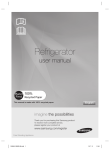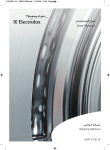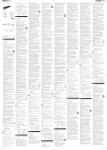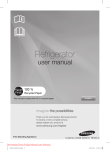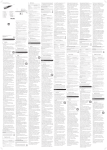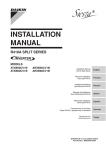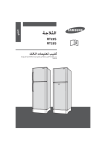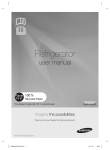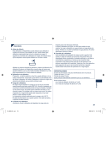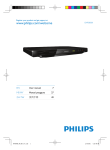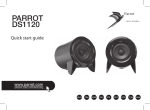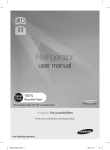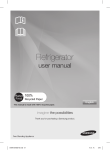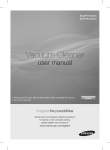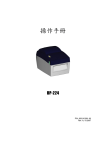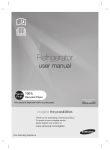Download Refrigerator - Samsung CTC Lebanon
Transcript
Refrigerator user manual This manual is made with 100% recycled paper. imagine the possibilities Thank you for purchasing this Samsung product. To receive more complete service, please register your product at www.samsung.com/register Free Standing Appliance DA99-01950G-09.indb 1 English safety information SAFETY INFORMATION • Before operating the appliance, please read this manual thoroughly and retain it for your reference. • Use this appliance only for its intended purpose as described in this instruction manual. This appliance is not intended for use by persons (including children) with reduced physical, sensory or mental capabilities, or lack of experience and knowledge, unless they have been given supervision or instruction concerning use of the appliance by a person responsible for their safety. • Because these following operating instructions cover various models, the characteristics of your refrigerator may differ slightly from those described in this manual. Important safety symbols and precautions : WARNING CAUTION Hazards or unsafe practices that may result in severe personal injury or death. Hazards or unsafe practices that may result in minor personal injury or property damage. Do NOT attempt. Do NOT disassemble. Do NOT touch. Follow directions carefully. Unplug the power plug from the wall socket. Make sure the machine is grounded to prevent electric shock. Call the contact center for help. Note. 2_ safety information '$ * LQGE 6 HF These warning signs are here to prevent injury to you and others. Please follow them carefully. After reading this section, keep it in a safe place for future reference. WARNING SEVERE WARNING SIGNS FOR INSTALLATION • Do not install the refrigerator in a damp place or place where it may come in contact with water. - Deteriorated insulation of electrical parts may cause an electric shock or fire. • Do not place this refrigerator in direct sunlight or expose to the heat from stoves, room heaters or other appliance. • Never use gas pipes, telephone lines or other potential lightening rods as ground. - Improper use of the ground plug can result in electric shock. • Do not plug several appliances into the same multiple power board. The refrigerator should always be plugged into its own individual electrical which has a voltage rating that matched the rating plate. - This provides the best performance and also prevents overloading house wiring circuits, which could cause a fire hazard from overheated wires. • If the wall socket is loose, do not insert the power plug. - There is a risk of electric shock of fire. • Do not use a cord that shows cracks or abrasion damage along its length or at either end. • Do not bend the power cord excessively or place heavy articles on it. • This refrigerator must be properly installed and located in accordance with the manual before it is used. • Connect the power plug in proper position with the cord hanging down. - If you connect the power plug upside down, wire can get cut off and cause fire or electric shock. • When moving the refrigerator, be careful not to roll over or damage the power cord. - This constitutes a fire hazard. • Make sure that the power plug is not squashed or damaged by the back of the refrigerator. • Keep the packing materials out of reach of children. - There is a risk of death from suffocation if children put them on their head. • The appliance must be positioned so that the plug is accessible after installation. • The refrigerator must be grounded. - You must ground the refrigerator to prevent any power leakages or electric shocks caused by current leakage from the refrigerator. • If the power cord is damaged, have it replaced immediately by the manufacturer or its service agent. • The fuse on refrigerator must be changed by a qualified technician or service company. - Failing to do so may result in electric shock or personal injury. CAUTION CAUTION SIGNS FOR INSTALLATION • Keep ventilation opening in the appliance enclosure or mounting structure clear of obstruction. • Allow the appliance to stand for 2 hours after installation. WARNING SEVERE WARNING SIGNS FOR USING • Do not put a container filled with water on the refrigerator. - If spilled, there is a risk of fire or electric shock. • Do not let children hang on the door. If not, a serious injury may occur. • Do not let children enter inside of the refrigerator. There is a risk of children entrapment. • Never put fingers or other objects into the dispenser hole. - It may cause personal injury or material damage. • Do not store volatile or flammable substances in the refrigerator. - The storage of benzene, thinner, alcohol, ether, LP gas and other such products may cause explosions. • Do not store pharmaceuticals products, scientific materials or temperature sensitive products in the refrigerator. - Products that require strict temperature controls must not be stored in the refrigerator. • Do not place or use electrical appliance inside the refrigerator, unless they are of a type recommended by the manufacturer. • Do not use mechanical devices or any other means to accelerate the defrosting process, other than those recommended by the manufacturer. • Do not damage the refrigerant circuit. • Do not disassemble or repair the refrigerator by yourself. - You run risk of causing a fire, malfunction and/or personal injury. • Children should be supervised to ensure that they do not play with the appliance. • Bottles should be stored tightly together so that they do not fall out. • This product is intended only for the storage of food in a domestic environment. • If a gas leak is detected, avoid any naked flames or potential sources of ignition and air the room in which the appliance is standing for several minutes. • Use only the LED Lamps provided by manufacturer or service agents. • Do not insert the power plug with wet hands. • Do not store articles on the top of the appliance. - When you open or close the door, the articles may fall and cause personal injury and/or material damage. safety information _3 '$ * LQGE 6 HF • If you smell pharmaceutical or smoke, pull out power plug immediately and contact your Samsung Electronics service center. • If you experience difficulty when changing the light, contact service agents. • If the products equipped with LED Lamp, do not disassemble Lamp Cover and LED Lamp by yourself. - Please contact your service agents. CAUTION CAUTION SIGNS FOR USING • To get Best performance of product, - Do not place foods too closely in front of the vents at the rear of the appliance as it can obstruct free air circulation in the refrigerator compartment. - Wrap the food up properly or place it in airtight containers before put it into the refrigerator. • Fill water tank, ice tray, water cubes only with potable water. • If the refrigerator is damaged by water, pull out the power plug and contact your Samsung Electronics service center. CAUTION CAUTION SIGNS FOR CLEANING • Do not directly spray water inside or outside the refrigerator. - There is a risk of fire or electric shock. • Do not spray inflammable gas near the refrigerator. - There is a risk of explosion or fire. • Do not spray cleaning products directly on the display. - Printed letters on the display may come off. • Remove any foreign matter or dust from the power plug pins. But do not use a wet or damp cloth when cleaning the plug, remove any foreign material or dust from the power plug pins. - Otherwise there is a risk of fire or electric shock. 4_ safety information '$ * LQGE 6 HF • Unplug the refrigerator before cleaning and making repairs. WARNING SEVERE WARNING SIGNS FOR DISPOSAL • When disposing of this or other refrigerators, remove the door/door seals, door latch so that small children or animals cannot become trapped inside. Children should be supervised to ensure that they do not play with the appliance. • Please dispose of the packaging material for this product in an environmentally friendly manner. • Leave the shelves in place so that children may not easily climb inside. Ensure that none of the pipes on the back of the appliance are damaged prior to disposal. • R600a or R134a is used as a refrigerant. Check the compressor label on the rear of the appliance or the rating label inside the refrigerator to see which refrigerant is used for your refrigerator. When this product contains flammable gas (Refrigerant R600a), contact your local authority in regard to safe disposal of this product. Cyclopentane is used as a insulation blowing gas. The gases in insulation material require special disposal procedure. Please contact your local authorities in regard to the environmentally safe disposal of this product. Ensure that none of the pipes on the back of the appliances are damaged prior to disposal. The pipes shall be broke in the open space. • If the appliance contains iso-butane refrigerant (R600a), a natural gas with high environmental compatibility that is, however, also combustible. When transporting and installing the appliance, care should be taken to ensure that no parts of the refrigerating circuit are damaged. • Refrigerant squirting out of the pipes could ignite or cause an eye injury. If a leak is detected, avoid any naked flames or potential sources of ignition and air the room in which the appliance is standing for several minutes. • In order to avoid the creation of a flammable gas-air mixture if a leak in the refrigerating circuit occurs, the size of the room in which the appliance may be sited depends on the amount of refrigerant used. Never start up an appliance showing any signs of damage. If in doubt, consult your dealer. The room must be 1m³ in size for every 8g of R600a refrigerant inside the appliance. The amount of refrigerant in your particular appliance is shown on the identification plate inside the appliance. ADDITIONAL TIPS FOR PROPER USAGE • In the event of a power failure, call the local office of your Electricity Company and ask how long it is going to last. - Most power failures that are corrected in an hour or two will not affect your refrigerator temperatures. However, you should minimize the number of door openings while the power is off. • If the key is provided with refrigerator, the keys should be kept out of the reach of children and not in vicinity of the appliance. • The appliance might not operate consistently (possibility of temperature becoming too warm in refrigerator) when sited for an extended period of time below the cold end of the range of temperatures for which the refrigerating appliance is designed. • Do not store food which spoils easily at low temperature, such as bananas, melons. • Your appliance is frost free, which means there is no need to manually defrost your appliance, as this will be carried out automatically. contents SETING UP YOUR SIDE-BY-SIDE REFRIGERATOR ·····································6 OPERATING YOUR REFRIGERATOR ····························································10 TROUBLESHOOTING ·····················································································14 INSTALL YOUR REFRIGERATOR···································································15 safety information _5 '$ * LQGE 6 HF setting up your refrigerator 100 mm GETTING READY TO INSTALL THE REFRIGERATOR Congratulations on your purchase of this Samsung Refrigerator. We hope you enjoy the state-of-art features and efficiencies that this new appliance offers. • This refrigerator must be properly installed and located in accordance with the manual before it is used. • Use this appliance only for its intended purpose as described in this instruction manual. • We strongly recommend that any servicing be performed by a qualified individual. • Please dispose of the packaging material for this product in an environmentally friendly manner. 1800 mm or 1650 mm 50 mm 600 mm at least 50 mm Pull the power plug out of the socket before changing the interior light of the WARNING refrigerator. - Otherwise, there is a risk of electric shock. 550 mm 1,175 mm 1,010 mm Selecting the best location for the refrigerator • A location without direct exposure to sunlight. • A location with flat floor surface. • A location with enough space for the refrigerator door to open easily. • Allow sufficient space to the right, left, back and top for air circulation. If the refrigerator does not have enough space, the internal cooling system may not work properly. • Please ensure that appliance can be moved freely in the event of maintenance & service. 6_ setting up '$ * LQGE 6 HF • Height of the product may be different depending on the models. • Allow clearance to the right, left, back and top when installing. This will help reduce power consumption and keep your energy bills lower. • Do not install the refrigerator in a place with the temperature lower than 10°C. Pull the unit straight out when installing, servicing or cleaning behind the CAUTION refrigerator and push it straight back after work is complete. Make sure your floor can support fully loaded refrigerator. REVERSING THE REFRIGERATOR DOOR 3. Disconnect the wires and then remove 3 bolts. Any damage caused while attempting to reverse the door opening is not covered under the appliance manufactures warranty. Any repairs requested due to this circumstance will be completed on a chargeable basis at the customers expense. WARNING Make sure your refrigerator is unplugged before handling electrical wires. 4. Remove the door from the lower hinge by carefully lifting the door straight up. Required Tools (Not provided) Phillips Head Driver (+) Flat Head Driver (-) 10 mm Socket Wrench (for bolts) Refrigerator door is heavy, be careful not to injure yourself when removing the CAUTION refrigerator door. 8 mm Socket Wrench (for bolts) Spanner (for hinge shaft) 4 mm Hex Wrench (for bottom hinge shaft) 5. Separate the front leg cover after removing 2 screws. 1. Remove 2 screws on the top of the refrigerator. Screw Screw 2. Remove the plastic cover and make sure to disconnect the wire connected to it. After removing the plastic cover, check the parts for reversing the door. 6. Unscrew 3 bolts tightening the hinge and also unscrew 3 bolts on the bottom left side by the front leg where removed hinge will be attached. 10mm 10mm CAUTION Be careful not to damage the electrical wires when removing the plastic cover. setting up _7 '$ * LQGE 6 HF 01 SETTING UP Samsung recommends that reversing of the door opening is only completed by WARNING Samsung approved Service providers. This will be on a chargeable basis and at the customers expense. 7. Separate the hinge shaft by using hex wrench first. Unscrew the bolt to remove the hinge riser and switch the side of the hinge shaft and the hinge riser. 11. Remove the hinge and the grommet from the refrigerator door. Detach the right side hinge cover and pull the wires out of the hinge cover. Hinge shaft Hinge cover Grommet Hinge riser 8mm Bolt CAUTION 8. Attach the hinge on the bottom left side of the refrigerator where bolts were previously removed in step 6. Screw the bolts that were removed on the bottom right side of the refrigerator for the future usage. Be careful not to damage the electrical wires when removing the hinge cover. 12. Use wrench to separate the hinge shaft and then flip the hinge and reattach the hinge shaft. 10mm 10mm 9. Remove the screws on the bottom left and right side of the refrigerator door. Switch the side of the door stopper from right to the left. Hinge riser should be switched as well. Hinge riser 13. Reassemble the hinge on the refrigerator door by reversing the step 11. Make sure to use left side hinge cover (which can be found underneath the removed plastic cover from step 2) and remove the grommet. After reassembling the hinge, wire and the hinge cover, switch the side from right to the left. Hinge riser Grommet 10. Remove the wire cover on top of the refrigerator door to switch the side of the wires. 14. After switching the hinge, close it with the wire cover on the top of refrigerator door. “Cover Wire Door R” can be found in the packaging 8_ setting up '$ * LQGE 6 HF 15. Take off the handle cover and remove the screws, make sure to detach the caps and the handle from the left to right side of the door. (Make sure to cover the left side with detached caps.) 19. Tighten 2 screws back to its place. Handles may not have cover depending on the models. 16. Switch the hinge cap and attach the front leg cover. Carefully put the refrigerator door back on. Hinge cap 17. Tighten the 3 bolts and then connect the wires back together. • After reversing the doors, make sure the Fridge and Freezer door gaskets are WARNING properly arranged. If not, there might be a noise or dew formed which affects perfomance of the refrigerator. LEVELLING THE REFRIGERATOR If the front of the appliance is slightly higher than the rear, the door can be opened and closed more easily. Turn the adjusting legs clockwise to raise and counter-clockwise to lower the height. Case 1) The appliance tilts down to the left. • Turn the left adjusting leg in the direction of the arrow until the appliance is level. Case 2) The appliance tilts down to the right. • Turn the right adjusting leg in the direction of the arrow until the appliance is level. WARNING Make sure your refrigerator is unplugged before handling electrical wires. 18. Connect the wire on the plastic cover and put the cover back to its original position. < Case1 > < Case2 > setting up _9 '$ * LQGE 6 HF 01 SETTING UP 20. Detach the Fridge and the Freezer door gaskets and then attach them after rotating them 180˚. operating your refrigerator CHECKING THE CONTROL PANEL 1 2 3 (Hold 3 sec for Display) 4 5 3 Power Cool function cannot be used together with Vacation function. Selecting Vacation function will automatically deactivate the Power Cool function. Each time you press the button, a short beep will sound. 4 USING THE CONTROL PANEL 1 Child Lock Press the Child Lock button for 3 seconds to activate the Child Lock function. Child lock indicator will light up and all the buttons on the control panel will be locked. To deactivate the Child Lock function, press the Child Lock button again for 3 seconds. 2 Fridge Press the Fridge button to set the desired temperature from the range between 1°C and 7°C. Default set temperature is set on 3°C and each time you press the Fridge button, temperature will change in following order and temperature indicator will display the desired temperature. When the temperature setting is done, temperature indicator will display the current temperature of the refrigerator. If current temperature is higher than 9°C, temperature indicator will be displayed as 9°C. 10_ operating '$ * LQGE Power Cool Press the Power Cool button to activate the Power Cool function. Power Cool indicator will light up and the refrigerator will speed up the time to needed to cool products in the refrigerator. Power Cool function will operate for 2 hours and 30 minutes to quickly cool the refrigerator. To deactivate the Power Cool function, press the Power Cool button again. Alarm 1. Alarm Press the Alarm button to activate the Alarm function. Alarm indicator will light up and the refrigerator will alert you with alarm sound if the refrigerator door is kept open for longer than 2 minutes. To deactivate the Alarm function, press the Alarm button again. 2. Display Off As standard, the temperature display is switched off, to switch between on and off mode, press alarm button for 3 seconds. 5 Vacation Press the Vacation button to activate the Vacation function. Vacation indicator will light up and the refrigerator will set the temperature to 15°C to minimize the power consumption while you are away (on vacation or business trip etc). Keep the refrigerator free from bacteria and odor. • Vacation function will be automatically deactivated If you select Power Cool function or adjust temperature while Vacation function is on. • Make sure to remove foods before using Vacation function. USING THE MOISTURE CONTROL BIG BOX 1 You can use the moisture control big box to control the humidity for the products which needs to be preserved its freshness. • Some of the features such as water tank and the beverage station can be different and may not be available depending on the model. • To get more space, you can remove water 1 tank. It does not affect thermal and mechanical characteristics. A declared storage volume of refrigerator compartment is calculated with this part removed. USING THE BEVERAGE STATION To open the beverage station, push the top part of the beverage station. Anti-sweat heater switch When the humidity of the indoor is high, sweat may form around the beverage station. Turn the Anti-sweat heater switch on, to remove the sweat and turn the switch off when the sweat disappears. Anti-sweat heater switch USING THE FOLDABLE SHELF You can tuck in the foldable shelf if you need to accommodate taller containers or products on the shelf underneath. Beverage station may not be available depending on the model. 1. Slightly lift up the shelf and slide it inward. 2. You can simply pull the tucked in shelf to use the fully extended shelf. operating _11 '$ * LQGE 02 OPERATING Use the humidity control lever on the top of the drawer to adjust the humidity. Move the lever to the right side to keep the humidity low within the drawer. Move the lever to the left side to keep the humidity high. More holes will allow higher humidity within the drawer. USING THE WATER DISPENSER Filling the water You can fill the water with the water tank sitting inside of the refrigerator or you can remove the water tank to fill the water. Method 1 Fill the water through the hole on the top of the water tank. If you pour the water too fast, water may overflow. Method 2 1. Release the lock on the both side of the water tank to remove the lid on the water tank. REMOVING THE INTERIOR PARTS Moveable deli bin Pull the deli bin out fully then slightly lift it up to remove it. Shelves Gently lift up the shelves with both hands and pull it toward you. (Glass shelf/Foldable shelf) 2. Fill the water in the water tank. Drawers Pull the drawers out fully then slightly lift it up to remove the drawers. (Plastic drawer/Moisture control big box) CAUTION Do not put anything other than water in the water tank. Getting water from the dispenser Door guards Place a glass underneath the water outlet and push it gently against the water dispenser lever with your glass. Blue light will turn on when you push the lever. Firmly grab the door guards with both hands and lift it up gently to remove the door guards. • Make sure the glass is in line with the dispenser to prevent the water from splashing out. • Water dispenser may not be available depending on the model. Water tank Firmly grab the water tank with both hands and lift it up towards you gently to remove the water tanks. Water tank may not be available depending on the model. 12_ operating '$ * LQGE Beverage station 1. Remove the door bin locate on the top of the beverage station. 02 OPERATING 2. Press the bottom left and right part of the beverage station with both hands lift up to open. Beverage station may not be available depending on the model. Deodorizer Push the lever as arrow indicates and pull the cover. To get the best energy efficiency of this product, please leave all selves, drawers and baskets on their original position like as illustration in page (11). CLEANING THE REFRIGERATOR WARNING CAUTION Do not use Benzene, Thinner or Clorox™ for cleaning. They may damage the surface of the appliance and can create a risk of fire. Do not spray the refrigerator with water while it is plugged in, as it may cause an electric shock. Do not clean the refrigerator with benzene, thinner or car detergent for risk of fire. REPLACING THE INTERIOR LIGHT Please contact your service agents. operating _13 '$ * LQGE troubleshooting PROBLEM The appliance is not operating at all or the temperature is too high. SOLUTION • Check if the power plug is correctly connected. • Is the temperature control on the front panel correctly set? • Does sun shine on the appliance or are there any heat sources nearby? • Is the back of the appliance too close to the wall? • Check if the appliance is installed on a stable and even floor. • Is the back of the appliance too close to the wall? There are unusual noises. • Have any foreign objects fallen behind or under the appliance? • Is the noise coming from the compressor in the appliance? • A ticking sound may be heard inside the appliance; this is normal. This sound occurs when the various accessories contract or expand. The front corners and sides of the appliance are warm and condensation starts to form. You can hear a liquid bubbling in the appliance. • Heat-proof pipes are installed in the front corners of the appliance to prevent condensation from forming. When the surrounding temperature rises, this may not always be effective. However, this is not abnormal. • In very humid weather, condensation may form on the outer surface of the appliance when the moisture in the air comes into contact with the cool surface of the appliance. • This is the refrigerant, which cools the inside of the appliance. • Is there any spoiled food inside of the refrigerator? There is a bad smell inside the appliance. There is a layer of frost on the appliances walls. Condensation forms on the inside wall of the appliance and around vegetables. 14_ troubleshooting '$ * LQGE • Make sure that strong smelling food (for example, fish) is wrapped so that it is airtight. • Clean out your refrigerator periodically and throw away any spoiled or suspect food. • Are the air outlet vents blocked by food stored inside the refrigerator? • Space the food out as much as possible to improve ventilation. • Is the door fully closed? • Food with a high water content is stored uncovered with a high humidity level or the door has been left open for a long time. • Store the food with a cover or in sealed containers. How to install the product Make sure to turn off the power for both of the products. Installation Part Installing the products together 1. Keep the distance between the refrigerator and the freezer about 5~7mm. 2. Remove the front leg cover on both refrigerator and the freezer by removing the screws. Side by Side combination possible with Samsung Models starting with R Z**,RR**. Please ask the shop for detail such as Color and Design. For Side by Side arrangement, please make sure followings. - Recommend to place the Fridge on the Right for best performance - For perfect finish, allow the following clearance and install SPACERS in installation Kit provided. (Only available on some models) - Make the height of the refigerator and the freezer same with refering the 9 page. 3. Remove the screw from the each of the product and attach them back after putting the bottom fixer. Install Direction Fixer Joining Strip Bottom Fixer A 4. Insert the joining strip in between the refrigerator and the freezer. Freezer Refrigerator 5. Insert two fixers firmly on the top of the products. Bottom Fixer A Front Leg Cover Fixer 6. Place the front leg cover back on both of the products. at least 50mm Joining Strip 1175 at least 50mm Install Direction 2030 7. Join the bottom fixer B with screws at back of the products. Required Tools Fixer Joining Strip Bottom Fixer A, B Screws Bottom Fixer B install your refrigerator _15 '$ * LQGE Ambient Room Temperature Limits This refrigerator is designed to operate in ambient temperatures specified by its temperature class marked on the rating plate. Class Symbol Ambient Temperature range (°C) Extended Temperate SN +10 to +32 +16 to +32 Temperate N Subtropical ST +16 to +38 Tropical T +16 to +43 Internal temperatures may be affected by such factors as the location of the refrigerator, ambient temperature and the frequency with which you open the door. Adjust the temperature as required to compensate for these factors. '$ * LQGE Réfrigérateur mode d’emploi Ce manuel est en papier recyclé à 100%. imaginez les possibilités Merci d’avoir acheté ce produit Samsung. Pour bénéficier d’une assistance technique plus complète, enregistrez votre produit sur : www.samsung.com/register Appareil en pose libre DA99-01950G-09.indb 1 Français consignes de sécurité CONSIGNES DE SÉCURITÉ • Avant de mettre l’appareil en service, lisez attentivement ce mode d’emploi et conservez-le pour vous y référer ultérieurement. • Utilisez cet appareil uniquement dans le but pour lequel il a été conçu, conformément aux instructions de ce mode d’emploi. Cet appareil ne doit pas être utilisé par des personnes (y compris des enfants) dont les capacités physiques, sensorielles ou mentales sont diminuées ou qui n’ont pas l’expérience ou les connaissances nécessaires, sauf si elles sont placées sous la surveillande d’une personne responsable de leur sécurité ou si cette personne leur a communiqué les instructions nécessaires pour utiliser le congélateur. • Ce manuel étant commun à plusieurs modèles, les caractéristiques de votre réfrigérateur peuvent légèrement différer de celles décrites dans le présent mode d’emploi. Précautions et symboles de sécurité importants : DANGER ATTENTION Risques ou mauvaises manipulations pouvant provoquer des blessures graves ou la mort. Risques ou mauvaises manipulations pouvant provoquer des blessures légères ou des dommages matériels. N’essayez RIEN. Ne démontez PAS. Ne touchez PAS. Suivez soigneusement les consignes. Débranchez la fiche d’alimentation de la prise secteur. Assurez-vous que la machine est mise à la terre pour empêcher les électrocutions. Contactez le centre technique pour une assistance. Remarque. 2_ consignes de sécurité '$ * LQGE 6 HF Ces pictogrammes visent à préserver les utilisateurs de l’appareil de tout risque de blessure. Nous vous prions de respecter ces instructions. Après les avoir lues attentivement, conservez-les pour pouvoir les consulter ultérieurement. DANGER CONSIGNES DE SÉCURITÉ IMPORTANTES POUR L’INSTALLATION • N’installez pas le réfrigérateur dans une pièce humide ou un endroit où il est susceptible d’entrer en contact avec l’eau. - Un défaut d’isolation des composants électriques peut entraîner une électrocution ou un incendie. • Ne placez pas l’appareil dans un endroit exposé au rayonnement direct du soleil ou à proximité d’une source de chaleur (cuisinière, radiateur, etc.). • Ne reliez jamais la borne de terre de l’appareil à une conduite de gaz, une ligne téléphonique ou une tige de paratonnerre. - Une mise à la terre incorrecte peut provoquer une électrocution. • Ne branchez pas cet appareil sur une multiprise. Le réfrigérateur doit toujours être branché sur une prise électrique individuelle délivrant une tension conforme à la valeur indiquée sur la plaque signalétique de l’appareil. - Ainsi, votre appareil fonctionnera dans des conditions optimales et vous éviterez tout risque de surcharge des circuits électriques, de surchauffe des fils et donc, tout risque d’incendie. • Si la prise secteur est mal fixée au mur, ne branchez pas la fiche d’alimentation. - Vous risqueriez de vous électrocuter ou de provoquer un incendie. • N’utilisez jamais un cordon présentant des craquelures ou des signes d’usure. • Évitez de plier le cordon d’alimentation de manière excessive ou de le coincer sous un meuble lourd. • Avant toute utilisation, veillez à installer et positionner correctement l’appareil, conformément aux instructions. • Connectez la fiche d’alimentation correctement avec le cordon vers le bas. - Si la fiche est connectée à l’envers, le fil peut être coupé et provoqué un incendie ou une électrocution. • Lorsque vous déplacez l’appareil, veillez à ne pas écraser ou endommager le cordon d’alimentation. - Vous pourriez provoquer un incendie. • Assurez-vous que la fiche n’est pas écrasée ou n’a pas été endommagée en plaçant l’arrière de l’appareil trop près du mur. • Stockez les emballages hors de la portée des enfants. - Stockez les emballages hors de la portée des enfants. • Une fois l’appareil installé, la prise d’alimentation doit être facilement accessible. • Le réfrigérateur doit être mis à la terre. - Cette opération a pour but d’empêcher toute dissipation de puissance ou toute électrocution engendrée par une fuite de courant. • S’il est endommagé, faites-le immédiatement remplacer par le fabricant ou un technicien qualifié. • Le fusible du réfrigérateur doit être changé par un technicien ou un réparateur agréé. - Sinon, il existe un risque d’électrocution ou de blessure. ATTENTION CONSIGNES D’INSTALLATION • Veillez à ne pas obstruer les orifices de ventilation internes et externes. • Après l’installation, attendez deux heures avant d’utiliser l’appareil. DANGER CONSIGNES DE SÉCURITÉ IMPORTANTES POUR L’UTILISATION • Si vos mains sont mouillées, essuyez-les avant de raccorder l’appareil au secteur. • Évitez de poser des objets sur le réfrigérateur. - L’ouverture ou la fermeture de la porte pourrait provoquer la chute de ces objets, vous blesser et/ou endommager l’appareil. • Évitez de poser un récipient rempli d’eau sur le réfrigérateur. - En cas d’éclaboussures, vous pourriez vous électrocuter ou provoquer un incendie. • Ne laissez pas les enfants jouer avec la porte. Ils risqueraient de se blesser. • Ne laissez pas les enfants s’introduire dans le réfrigérateur. Un enfant risque de se retrouver piégé. • N’introduisez jamais vos doigts ni aucun objet dans l’orifice du distributeur d’eau. - Vous pourriez vous blesser ou endommager le système de distribution. • N’entreposez pas de substances volatiles ou inflammables dans le réfrigérateur. - Le stockage de benzène, de solvant, d’alcool, d’éther, de GPL ou d’un autre produit similaire peut provoquer une explosion. • N’entreposez pas de substances pharmaceutiques, d’équipements scientifiques ou de produits sensibles aux variations de température dans le réfrigérateur. - Les produits nécessitant un contrôle strict de la température ne doivent pas être stockés dans cet appareil. • Ne placez pas et n’utilisez pas d’appareils électriques à l’intérieur du réfrigérateur, sauf si ces derniers sont recommandés par le fabricant. • N’accélérez pas le processus de dégivrage à l’aide d’appareils ou de méthodes autres que ceux recommandés par le fabricant. • N’endommagez pas le circuit de réfrigération. • Ne tentez pas de démonter ou de réparer le réfrigérateur. - Vous pourriez déclencher un incendie, provoquer un dysfonctionnement et/ou vous blesser. • Les enfants doivent être surveillés afin de s’assurer qu’ils ne jouent pas avec l’appareil. • Afin d’éviter que les bouteilles ne tombent, il est conseillé de les regrouper. • Cet appareil a été conçu dans l’unique but de conserver des aliments dans un environnement domestique. • Si vous détectez une fuite de gaz, n’utilisez aucun objet susceptible de produire une flamme ou une étincelle. Aérez la pièce pendant plusieurs minutes. • Utilisez uniquement les DEL fournies par le fabricant ou des techniciens qualifiés. consignes de sécurité _3 '$ * LQGE 6 HF • Si vous détectez une odeur anormale ou de la fumée, débranchez immédiatement la fiche d’alimentation et contactez le centre technique Samsung Electronics le plus proche. • Si vous rencontrez des difficultés lors du remplacement de l’ampoule, contactez des techniciens qualifiés. • Si le produit est doté de DEL, ne tentez pas de démonter vous-même le cache de l’ampoule, ni la DEL. - Contactez les techniciens qualifiés les plus proches de chez vous. ATTENTION CONSIGNES D’UTILISATION • Afin de garantir des performances optimales : - Ne plaquez pas les aliments contre les orifices situés au fond de l’appareil. Vous risqueriez d’empêcher la circulation de l’air dans le réfrigérateur. - Emballez les aliments correctement ou placezles dans des récipients hermétiques avant de les mettre au réfrigérateur. • Remplissez le réservoir, le bac à glaçons, les glaçons uniquement avec de l’eau potable. • Si le réfrigérateur venait à être mouillé, débranchez la fiche d’alimentation et contactez le centre technique Samsung Electronics le plus proche. ATTENTION CONSIGNES DE NETTOYAGE • Ne vaporisez pas directement d’eau à l’intérieur ou sur l’extérieur de l’appareil. - Vous risqueriez de vous électrocuter ou de provoquer un incendie. • Ne vaporisez pas de gaz inflammable à proximité du réfrigérateur. - Vous pourriez provoquer une explosion ou un incendie. • Ne vaporisez pas de produits nettoyants directement sur l’afficheur. - Les lettres imprimées sur l’afficheur peuvent disparaître. • Retirez la poussière et les corps étrangers des broches. Mais pour nettoyer la fiche d’alimentation, utilisez un chiffon sec et retirez la poussière et les corps 4_ consignes de sécurité '$ * LQGE 6 HF étrangers présents dans les broches. - Vous risqueriez de vous électrocuter ou de provoquer un incendie. • Débranchez l’appareil avant toute opération de nettoyage ou de réparation. DANGER CONSIGNES DE MISE AU REBUT • Avant de vous débarrasser de cet appareil ou d’autres réfrigérateurs, retirez les portes, les joints de portes et les mécanismes de fermeture afin d’éviter qu’un enfant ou un animal ne s’y retrouve enfermé. Les enfants doivent être surveillés afin de s’assurer qu’ils ne jouent pas avec l’appareil. • Jetez l’emballage du produit en respectant les normes écologiques en vigueur. • Laissez les clayettes en place pour empêcher les enfants de rentrer dans l’appareil. Avant la mise au rebut, vérifiez que les tuyaux situés à l’arrière de l’appareil sont en bon état. • Selon le modèle, cet appareil peut utiliser du fluide frigorigène de type R600a ou R134a. Pour connaître le type de fluide utilisé, consultez l’étiquette apposée sur le compresseur, à l’arrière de l’appareil, ou la plaque signalétique située à l’intérieur du réfrigérateur. Si l’appareil contient un gaz inflammable (fluide frigorigène R600a), contactez les autorités locales pour connaître la procédure de mise au rebut adaptée. Cet appareil contient également une mousse isolante en cyclopentane. Les gaz contenus dans le matériau isolant doivent être éliminés selon une procédure spécifique. Contactez les autorités locales pour connaître la procédure de mise au rebut adaptée à ce type de produit. Avant la mise au rebut, vérifiez que les tuyaux situés à l’arrière de l’appareil sont en bon état. L’ouverture des tuyaux doit s’effectuer dans un lieu aéré. • Si le fluide frigorigène est de type R600a, sachez qu’il s’agit d’un gaz naturel écologique, mais également inflammable. Lors du transport et de l’installation de l’appareil, veillez à n’endommager aucune pièce du circuit de réfrigération. • Toute fuite pourrait entraîner l’inflammation du fluide frigorigène ou provoquer des lésions oculaires. Si vous détectez une fuite, n’utilisez aucun objet susceptible de produire une flamme ou une étincelle. Aérez la pièce pendant plusieurs minutes. • Pour éviter la formation d’un mélange gazair inflammable en cas de fuite du circuit de réfrigération, installez l’appareil dans une pièce dont le volume est adapté à la quantité de fluide frigorigène utilisée. Ne mettez jamais en service un appareil endommagé. En cas de doute, contactez votre revendeur. Prévoyez 1m³ pour 8 g de fluide R600a. Cette information est indiquée sur la plaque signalétique située à l’intérieur de l’appareil. CONSEILS SUPPLÉMENTAIRES • En cas de coupure de courant, contactez votre fournisseur d’électricité pour connaître la durée approximative de la panne. - En cas de coupure de courant inférieure à deux heures, la température de votre appareil restera inchangée. Vous devez néanmoins ouvrir les portes le moins souvent possible. • Si la clé est fournie avec le réfrigérateur, maintenez-la hors de la portée des enfants et éloignée de l’appareil. • Il se peut que l’appareil fonctionne de manière anormale (température devenue trop élevée dans le réfrigérateur) s’il est resté pendant une période prolongée au-dessous de la limite inférieure de la plage de températures pour laquelle il a été conçu. • Évitez de stocker des denrées facilement périssables à basse température (les bananes ou les melons, par exemple). • Votre appareil est équipé d’un système de dégivrage automatique, ce qui vous évite d’effectuer un dégivrage manuel. table des matières INSTALLATION DE VOTRE RÉFRIGÉRATEUR ··············································6 FONCTIONNEMENT DU RÉFRIGÉRATEUR ··················································10 DÉPANNAGE···································································································14 INSTALLATION DU RÉFRIGÉRATEUR ···························································15 consignes de sécurité _5 '$ * LQGE 6 HF installation de votre réfrigérateur PRÉPARATION DE L’INSTALLATION 100 mm Félicitations ! Vous venez d’acquérir un réfrigérateur Samsung. Nous espérons que ses fonctions innovantes répondront à toutes vos attentes. • Avant toute utilisation, veillez à installer et positionner correctement l’appareil, conformément aux instructions. • Utilisez cet appareil uniquement dans le but pour lequel il a été conçu, conformément aux instructions de ce mode d’emploi. • Toute réparation doit être effectuée par un professionnel qualifié. • Jetez l’emballage du produit en respectant les normes écologiques en vigueur. 1800 mm or 1650 mm 50 mm 600 mm Débranchez l’appareil avant de remplacer les ampoules. DANGER - Dans le cas contraire, vous pourriez vous électrocuter. au moins 50 mm 1,175 mm Choix du lieu d’installation • La pièce ne doit pas être exposée à la lumière directe du soleil. • La surface au sol doit être plane. • La pièce doit offrir un espace suffisant pour permettre d’ouvrir facilement la porte du réfrigérateur. • Prévoyez un espace suffisant à droite, à gauche, à l’arrière et en haut de l’appareil pour permettre à l’air de circuler. Si le réfrigérateur est plein, le système de refroidissement interne peut être davantage sollicité. • Assurez-vous de pouvoir déplacer l’appareil librement pour des besoins de maintenance et d’entretien. 6_ installation '$ * LQGE 6 HF 550 mm 1,010 mm • En fonction des modèles, il se peut que la hauteur du produit varie. • Prévoyez un espace suffisant tout autour de l’appareil lors de son installation. Vous réduirez ainsi sa consommation électrique. • N’installez pas le réfrigérateur dans une pièce où la température est inférieure à10 °C. Pendant l’installation, à l’occasion d’une réparation ou du nettoyage de l’arrière du réfrigérateur, tirez et replacez l’appareil en le déplaçant sur une ligne droite. Assurez-vous que le plancher peut supporter le poids du réfrigérateur plein. ATTENTION INVERSION DU SENS D’OUVERTURE DE LA PORTE DU RÉFRIGÉRATEUR DANGER 3. Débranchez les fils, puis retirez les 3 boulons. DANGER Tout endommagement provoqué par une tentative d'inversion du sens d'ouverture de la porte ne sera pas couvert par la garantie du fabricant de l'appareil. Toute réparation nécessaire suite à cela sera facturée aux frais du client. Assurez-vous que l’alimentation de votre réfrigérateur est coupée avant de manipuler les câbles électriques. 4. Dégagez la porte de la charnière inférieure en la soulevant doucement à la verticale. Outils nécessaires (non fournis) Tournevis Phillips (+) Tournevis plat (-) Clé à douille 10 mm (pour les boulons) ATTENTION Clé à douille 8 mm (pour les boulons) Clé (Pour l’axe de la charnière) Clé hexagonale (pour l’axe inférieur du battant) La porte du réfrigérateur est lourde. Veillez à ne pas vous blesser lors de son retrait. 5. Retirez la plinthe avant après avoir dévissé les 2 vis de fixation. 1. Retirez les 2 vis sur le dessus du réfrigérateur. Vis Vis 2. Retirez le capot en plastique et débranchez bien le fil qui y est relié. Vérifiez ensuite les éléments nécessaires pour retourner la porte. 6. Dévissez les trois boulons qui maintiennent la charnière et les 3 boulons placés du côté gauche, à l’endroit où vous allez fixer la charnière retirée sur le côté droit. 10mm Veillez à ne pas endommager les câbles électriques lors du retrait du couvercle en ATTENTION plastique. 10mm installation _7 '$ * LQGE 6 HF 01 INSTALLATION Samsung recommande de faire inverser le sens d'ouverture de la porte uniquement par des fournisseurs de service agréés par Samsung. Cela sera facturé aux frais du client. 7. Dévissez le boulon pour retirer la pièce métallique. Retirez l’axe du battant à l’aide de la clé hexagonale, et fixez l’axe et la pièce métallique de l’autre côté. Axe de la charnière 11. Retirez la charnière de la porte du réfrigérateur. Retirez le capot de la charnière droite et tirez les fils pour les sortir du capot. Cache de la charnière Rondelle Montant de la charnière Veillez à ne pas endommager les câbles électriques lors du retrait du couvercle de ATTENTION la charnière. Boulon de 8 mm 8. Fixez la charnière sur la partie inférieure gauche du réfrigérateur, à l’endroit où se trouvaient les boulons retirés à l’étape 6. Vissez les boulons sur la partie inférieure droite du réfrigérateur pour pouvoir les réutiliser en cas de besoin. 12. À l’aide de la clé, retirez l’axe du battant puis retournez la charnière et refixez son axe. 10mm 10mm 9. Retirez les vis placées sous la porte du réfrigérateur, à gauche et à droite. Retirez les butées de porte du côté droit pour les placer à gauche. Montant de la charnière 13. Remontez la charnière sur la porte du réfrigérateur en suivant les étapes du point 11 dans l’ordre inverse. Utilisez bien le capot de charnière gauche, que vous trouverez sous le capot de plastique retiré à l’étape 2. Après avoir remonté la charnière, les fils et le capot de charnière, remettez-les en place, mais du côté gauche. Montant de la charnière Rondelle 10. Retirez le cache sur le dessus de la porte du réfrigérateur, pour changer les fils de côté. 14. Après avoir inversé la charnière, remettez l a protection des fils électriques en haut de la porte du réfrigérateur. La mention “Cover Wire Door R” peut figurer sur l’emballage 8_ installation '$ * LQGE 6 HF 15. Retirez la poignée du côté gauche, pour la placer à droite. (Assurez-vous pour couvrir le côté droit avec les bonnets détachés.) 19. Serrez les 2 vis. En fonction des modèles, il se peut que les poignées ne disposent pas de couvercle. 16. Fixez la plinthe avant et remettez doucement la porte du réfrigérateur en place. Cache de la charnière 17. Serrez les 3 boulons, puis rebranchez les fils. • Une fois les portes du réfrigérateur et du congélateur inversées, assurezvous que DANGER leurs joints sont correctement disposés. Si ce n’est pas le cas, un bruit ou de la condensation peuvent apparaître et affecter les perfomances du réfrigérateur. MISE À NIVEAU DU RÉFRIGÉRATEUR Si l’appareil penche légèrement en arrière, la porte s’ouvrira et se fermera plus facilement. Tournez les pieds dans le sens des aiguilles d’une montre pour lever l’appareil, et en sens inverse pour l’abaisser. DANGER Assurez-vous que l’alimentation de votre réfrigérateur est coupée avant de manipuler les câbles électriques. Cas 1) L’appareil penche à gauche. • Tournez le pied de réglage gauche dans le sens indiqué par la flèche jusqu’à ce que l’appareil soit parfaitement horizontal. Cas 2) L’appareil penche à droite. • Tournez le pied de réglage droit dans le sens indiqué par la flèche jusqu’à ce que l’appareil soit parfaitement horizontal. 18. Branchez le fil sur le capot de plastique, puis remettez ce dernier en place. < Cas 1 > < Cas 2 > installation _9 '$ * LQGE 6 HF 01 INSTALLATION 20. Retirez les joints des portes du réfrigérateur et du congélateur, puis fi xez-les après les avoir fait tourner de 180˚. fonctionnement du réfrigérateur CHECKING THE CONTROL PANEL 1 2 3 (Hold 3 sec for Display) 4 5 3 Le mode Power Cool ne peut pas être utilisé en même temps que la fonction Vacation. Sélectionner la fonction Vacation désactive automatiquement le mode Power Cool. Chaque pression sur une touche s’accompagne d’un bref signal sonore. 4 UTILISATION DU PANNEAU DE COMMANDE 1 Child Lock Appuyez sur la touche Child Lock durant 3 secondes pour activer la fonction de sécurité enfants. L’indicateur de verrouillage s’allume et tous les boutons du panneau de commande d sont désactivés. Pour désactiver la sécurité, appuyez à nouveau sur la touche Child Lock durant 3 secondes. 2 Alarm 1. Alarm Appuyez sur la touche Alarm pour activer la fonction d’alarme. L’indicateur d’alarme s’illumine et le réfrigérateur vous alertera par un signal sonore si la porte reste ouverte plus de l d 2 minutes. Pour désactiver l’alarme, appuyez à nouveau sur la touche Alarm. 2. Affichage désactivé En principe, l’affichage de la température est éteint, pour basculer entre le mode activé et le mode désactivé, appuyez sur le bouton d’alarme pendant 3 secondes. Fridge Appuyez sur la touche Fridge pour sélectionner la température choisie dans la plage entre 1°C et 7°C. Par défaut, la température est réglée à 3°C. Chaque pression sur la touche Fridge modifie la température en suivant l’ordre de la séquence ci-après, et l’indicateur affiche la température sélectionnée. Une fois le réglage de la température terminé, l’indicateur affiche la température réelle à l’intérieur du réfrigérateur. Si la température réelle est supérieure à 9 °C, l’indicateur affichera 9 °C. 10_ fonctionnement '$ Power Cool Appuyez sur la touche Power Cool pour activer la fonction Power Cool. L’indicateur Power Cool s’illumine et le délai nécessaire pour refroidir les produits placés dans l’appareil diminue. La fonction Power Cool reste active durant 2 heures et 30 minutes pour refroidir rapidement le réfrigérateur. Pour désactiver la fonction Power Cool, appuyez à nouveau sur la touche Power Cool. * LQGE 5 Vacation Appuyez sur la touche Vacation pour activer la fonction Vacation. L’indicateur Vacation s’illumine et le réfrigérateur règle la température à 15 °C pour limiter la consommation d’électricité pendant votre absence (vacances, déplacement professionnel) tout en évitant le développement de bactéries et d’odeurs. • La fonction Vacation est automatiquement désactivée si vous sélectionnez le mode Power Cool ou si vous réglez la température. • Retirez bien tous les aliments de l’appareil avant d’activer la fonction Vacation. UTILISATION DU BAC À HUMIDITÉ CONTRÔLÉE 1 Le bac à humidité contrôlée permet de préserver la fraîcheur des produits sensibles. UTILISATION DU MINIBAR • Certaines caractéristiques, comme le réservoir d’eau ou le minibar, peuvent être différentes - voire ne pas être proposées selon les modèles. • Pour gagner de la place, vous pouvez retirer le réservoir d’eau 1 . Cela n’affecte en rien les spécifications thermiques et mécaniques. Le volume indiqué pour le réfrigérateur est calculé en retirant ces éléments. UTILISATION DE LA CLAYETTE ESCAMOTABLE Vous pouvez escamoter cette clayette vers l’intérieur pour poser des récipients ou produit de grande taille sur l’étagère du dessous. Pour ouvrir le minibar, appuyez sur sa partie supérieure. Utilisation du réchauffeur anticondensation Lorsque le niveau d’humidité à l’intérieur est élevé, de la condensation peut se former autour de la station et du distributeur de boisson. Actionnez le commutateur du réchauffeur anticondensation pour retirer la condensation, et coupez-le lorsque la condensation a disparu. Interrupteur du réchauffeur anti-condensation Le minibar n’est pas disponible sur tous les modèles. 1. Soulevez légèrement la clayette et faites-la glisser vers l’intérieur. 2. Tirez simplement la clayette pour la déplier et utiliser toute sa surface. fonctionnement _11 '$ * LQGE 02 FONCTIONNEMENT Réglez l’humidité à l’aide du levier de commande placé sur le haut du bac. Poussez le levier vers la gauche pour réduire l’humidité à l’intérieur du bac. Poussez-le vers la droite pour augmenter l’humidité. Le taux d’humidité à l’intérieur du bac est proportionnel au nombre d’orifices ouverts. UTILISATION DU DISTRIBUTEUR D’EAU RETRAIT DES ÉLÉMENTS INTÉRIEURS Remplissage Casier amovible Vous pouvez remplir le distributeur sans sortir le réservoir d’eau du réfrigérateur, ou en le retirant. Tirez complètement le casier, puis soulevez-le légèrement pour le sortir. Méthode 1 Versez l’eau à travers l’orifice situé sur le dessus du réservoir d’eau. Ne versez pas trop vite pour éviter que l’eau déborde. Méthode 2 1. Relevez les fixations de part et d’autre du réservoir pour retirer le couvercle. Clayettes Soulevez doucement les clayettes en les tenant à deux mains, puis tirez-les vers vous. (clayettes en verre / clayette escamotable) 2. Versez l’eau dans le réservoir. Bacs ATTENTION Placez uniquement de l’eau dans le réservoir d’eau. Tirez complètement les bacs, puis soulevez-les légèrement pour les sortir. (bac en plastique / bac à humidité contrôlée) Distribution d’eau Balconnet grand format Placez un verre sous le distributeur et appuyez délicatement sur le levier avec le verre. Un témoin bleu s’allume lorsque vous appuyez sur le levier. Saisissez fermement le balconnet en le tenant deux mains, puis soulevezle doucement pour le retirer. • Placez correctement le verre sous le distributeur pour éviter toute projection d’eau. • Le réservoir d’eau n’est pas disponible sur tous les modèles. Réservoir d’eau Saisissez fermement le réservoir d’eau en le tenant à deux mains, puis soulevez-le doucement pour le retirer. Le réservoir d’eau n’est pas disponible sur tous les modèles. 12_ fonctionnement '$ * LQGE Minibar 1. Retirez le balconnet situé au-dessus du minibar. 02 FONCTIONNEMENT 2. Appuyez avec les deux mains sur les côtés droit et gauche du bas du minibar, puis soulevez-le pour l’ouvrir. Beverage station may not be available depending on the model. Destructeur d’odeurs Poussez le levier dans le sens indiqué par la flèche et tirez le couvercle. Pour optimiser la consommation d’énergie du réfrigérateur, laissez toujours les étagères, tiroirs et paniers dans leur position d’origine (voir page 11). NETTOYAGE DU RÉFRIGÉRATEUR DANGER ATTENTION N’utilisez pas de benzène, de solvant ou de Clorox™ lors du nettoyage. Vous risqueriez d’endommager la surface de l’appareil ou de provoquer un incendie. Ne projetez pas d’eau sur le réfrigérateur lorsque celui-ci est raccordé au secteur. Vous risqueriez de vous électrocuter. N’utilisez jamais de benzène, de solvant ou de détergent pour voiture afin d’éviter tout risque d’incendie. REMPLACEMENT DE L’AMPOULE Pour le remplacement d’ampoules LED, veuillez contacter un réparateur agréé. fonctionnement _13 '$ * LQGE dépannage PROBLÈME SOLUTION • Assurez-vous que la fiche d’alimentation est correctement branchée. L’appareil ne fonctionne pas du tout ou la température est trop élevée. • La température indiquée sur le panneau avant est-elle correctement réglée ? • L’appareil est-il directement exposé au soleil ou des sources de chaleur se trouvent-elles à proximité ? • L’arrière de l’appareil est-il placé trop près du mur ? • Assurez-vous que le sol sur lequel l’appareil est installé est de niveau et stable. L’appareil émet des bruits inhabituels. • L’arrière de l’appareil est-il placé trop près du mur ? • Des corps étrangers sont-ils tombés derrière ou sous l’appareil ? • Le bruit émis provient-il du compresseur placé dans l’appareil ? • L’appareil peut émettre des craquements ; ce bruit est normal. Il résulte de la dilatation ou de la contraction des différents accessoires. Les angles avant et les côtés de l’appareil sont chauds. Des gouttelettes de condensation se forment. Vous entendez un bruit d’écoulement d’eau. • L’installation de tuyaux calorifugés dans les angles avant de l’appareil préviennent ce phénomène. En cas de hausse de la température ambiante, cela peut s’avérer inefficace. Cependant, ce phénomène n’est pas anormal. • Dans un climat très humide, l’air humide entrant en contact avec la surface froide de l’appareil entraîne de la condensation sur les surfaces extérieures de l’appareil. • Ce bruit est produit par le fluide frigorigène lorsqu’il refroidit l’intérieur de l’appareil. • Le réfrigérateur contient-il des aliments avariés ? L’intérieur de l’appareil dégage des odeurs. Les parois de l’appareil sont couvertes de givre. • Placez les aliments qui dégagent une forte odeur, tels que le poisson, dans des emballages hermétiques. • Nettoyez régulièrement votre réfrigérateur et jetez tout aliment avarié ou présentant des traces suspectes. • Les orifices de ventilation sont-ils obstrués par les aliments entreposés dans le réfrigérateur ? • Espacez le plus possible les aliments afin d’optimiser la ventilation. • La porte est-elle bien fermée ? Des gouttelettes de condensation se forment sur les parois intérieures de l’appareil et les légumes. 14_ dépannage '$ * LQGE • Vous avez placé des aliments à forte teneur en eau sans les couvrir ou vous avez laissé la porte longtemps ouverte. • Couvrez vos aliments ou placez-les dans des récipients hermétiques avant de les ranger. Installation du produit Assurez-vous d’avoir coupé l’alimentation des deux appareils. Installation Installation simultanée des produits 1. Conservez un dégagement d’environ 5 à 7 mm entre le réfrigérateur et le congélateur. 2. Retirez le couvercle avant du réfrigérateur et du congélateur après avoir enlevé les vis. Combinaison possible d’installation côte à côte des modèles Samsung en commençant par R Z**,RR**. Veuillez contacter le magasin pour obtenir des détails sur la couleur et le design. Pour une installation côte à côte, veuillez vérifier les éléments suivants. - Il est recommandé de placer le réfrigérateur à droite pour obtenir de mei leures performances. - Pour une finition parfaite, respectez le dégagement suivant et installez les ENTRETOISES fournies dans le kit d’installation. (Option) - Réglez le réfrigérateur et le congélateur à la même hauteur en vous reportant à la page 9. 3. Retirez la vis de chaque appareil, placez l’élément de fixation inférieur et revissez. Direction d’installation Bande de jonction Elément de fixation Elément de fixation inférieur A 4. Insérez la bande de jonction entre le réfrigérateur et le congélateur. Congélateur Réfrigérateur 5. Insérez deux éléments de fixation dans la partie supérieure des appareils. Elément de fixation inférieur A Couvercle avant Elément de fixation au moins 50 mm Bande de jonction 6. Replacez le couvercle avant sur les deux appareils. 1175 au moins 50 mm Direction d’installation 2030 7. Fixez le support inférieur B avec des vis à l’arrière du produit. Outils nécessaires Elément de fixation Bande de jonction Elément de fixation inférieur A, B Vis Elément de fixation inférieur B Installation _15 '$ * LQGE Limites de température ambiante Ce réfrigérateur est conçu pour fonctionner dans les températures ambiantes correspondant à la classe de température indiquée sur la plaque signalétique de l’appareil. Classe Symbole Plage de température ambiante (°C) Tempérée élargie SN de +10 à +32 Tempérée N de +16 à +32 Subtropicale ST de +16 à +38 Tropicale T de +16 à +43 Les températures intérieures de l’appareil peuvent varier sous l’effet de facteurs tel que la pièce où il se trouve, la température ambiante et la fréquence d’ouverture de la porte. Ces facteurs peuvent être compensés en réglant une température appropriée. '$ * LQGE ǀƭƸƤȚǀźǍưŽȚȜȤȚǍŲǀűȤȢȢȶNjŲ ǀŲǞŽǟƴŸǀƇǤǞƓȚȜȤȚǍƑȚǀűȤȢǀƂƱŮȜȢNjƤȚǀƭƸƤȚȜȤȚǍƑȚȝƾűȤȢǠźǚƵƯƄŽNjƵƣȚǀűǾƅŽȚȵnjƀǛƸƵƫůƖ ǠŮǍƷƳŽȚNjƷƐȚǛƸŻ ǀƁǞƂƓȚǀűȤNjŽƾŮǀƭƸƤȚȜȤȚǍƑȚǀűȤȢȰƾƭſ ǎžǍŽȚ ǀƂƱŽȚ ȊȉǟŽȘȈȇ E@ ȜNjƄƛǀŽNjƄƯž ȊȉǟŽȘȈȍ @ ǀŽNjƄƯž ȊȏǟŽȘȈȍ EF ǀƸǣȚǞƄŴȚǝƃŵ ȋȊǟŽȘȈȍ F ǀƸǣȚǞƄŴȚ țƾƃŽȚljƄźȤȚǍƳůȲNjƯžȶǀƭƸƤȚȜȤȚǍƑȚǀűȤȢȶNjƵƣȚǀűǾƅŽȚǕŻǞžǚƅžǚžȚǞƯŮǀƸƴųȚNjŽȚȜȤȚǍƑȚȝƾűȤȢǍŰƺƄůNjŻ ǚžȚǞƯŽȚȵnjƀǒƁǞƯƄŽǀűƾƑȚƿƉŲȜȤȚǍƑȚǀűȤȢǓƃƬŮǛŻ DA99-01950G-09.indb 1 ƿƸƫƶƄŽȚȔǎű ǃƄƶƵŽȚƿƸƫƶůǀƲƁǍŶ ǜƸƆƄƶƵŽȚǾƳŽǀƃƉƶŽƾŮǀŻƾƭŽȚǚƸưƪůȯƾƲƁȘǜžNjżƺů ƾƃƁǍƲůǛžȎǟŽȘȌȤǎƁǍƱŽȚȶǀűǾƅŽȚǜƸŮǀƴǧƾźǀźƾƉƵŮǔƱƄŲȚȈ ǜŸȤǎƁǍƱŽȚȶǀűǾƅŽȚǜžǚżǟƴŸǀƸžƾžLjȚǚűǍŽȚȔƾƭŹȬǎſȘȉ ǀƸƃŽǞƴŽȚǍƸžƾƉƵŽȚǙźǘƁǍŶ ǕǤȶNjƯŮȷǍųȖȜǍžǝƭŮȤȚȶǃƄƶžǚżǜžǠƃŽǞƴŽȚȤƾƵƉƵŽȚǙźȊ ǠƴƱƉŽȚǁƃƅƵŽȚ ǒƯƃŽȚƾƷƬƯŮǕžȝƾƆƄƶƵŽȚƿƸƫƶů ȖNjƃůǠƄŽȚEO[ac\UȝǾƁȢǞžǕžǜƳƵžƿƶűǟŽȘƾƃƶűǕƵƆƵŽȚƿƸżǍƄŽȚ DDȶDLǎžǍŽƾŮ ǛƸƵƫƄŽȚȶȴǞƴŽƾŮǀǧƾƈŽȚǚƸǧƾƱƄŽȚȲǞŲǍƆƄƵŽȚǜžȤƾƉƱƄŴǽȚǟűǍƁ ǠƴƁƾƵžNjżƺƄŽȚǟűǍƁȆȤȶƾƆƄƵŽȚǛƸƮƶƄƴŽ ȔȚȢȖǚƬźȖǟƴŸȲǞƫƇƴŽǜƸƵƸŽȚǟƴŸǀűǾƅŽȚǕǤǞŮǟǧǞƁ ǕžȜȢȶǎƵŽȚȝȚNjŸƾƃƵŽȚƿƸżǍƄŮǛŻȶǀƸŽƾƄŽȚȨǞƴƈŽȚǀźƾƉžȱǍůȚȆǠŽƾƅƵŽȚȲƾƵƳƄŴǾŽȶ ǓƲźȝǾƁȢǞƵŽȚǒƯŮǠźǍźǞƄžƿƸżǍƄŽȚǀŸǞƵƆž ȐǀƇƱǧǟŽȘȬǞűǍŽȚǕžȤǎƁǍƱŽȚȬƾƱůȤȚǏƱſǞƀǀűǾƅŽȚȬƾƱůȤȚǚƯűȘ ƿƸƫƶƄŽȚȵƾƆůȚ ǁƃƅƵŽȚ ǓŮȤǓƁǍŵ 3ǠƴƱŴǁƃƅž ȤǎƁǍƱŽȚȶǀűǾƅŽȚǜƸŮƾƵƸźǓŮǍŽȚǓƁǍŵǚųȢȖȋ ȤǎƁǍƱŽȚ ǀűǾƅŽȚ ȝƾƆƄƶƵŽȚǜžȸǞƴƯŽȚȔǎƆŽȚǟƴŸȳƾƳŲƼŮǜƸƄƃƅƵŽȚǚųȢȖȌ 3ǠƴƱŴǁƃƅž ǀƸžƾžLjȚǚűǍŽȚȔƾƭŹ ǁƃƅƵŽȚ ǟƴŸǛžȇȌ ǚŻLjȚ ǓŮȤǓƁǍŵ 1175 ǜƸƆƄƶƵŽȚǾżǟƴŸȷǍųȖȜǍžǀƸžƾžLjȚǚűǍŽȚȔƾƭŹƿżȤȍ ǟƴŸǛžȇȌ ǚŻLjȚ ƿƸƫƶƄŽȚȵƾƆůȚ 2030 ǠƱƴƈŽȚȔǎƆŽȚǠźǀƸƃŽǞƴŽȚǍƸžƾƉƵŽȚǕž4ȬƾƲŽȚǁƃƅžǓŮȤȚȎ ȝƾƆƄƶƵŽȚǜž 4ǠƴƱŴǁƃƅž ȈȌǀűǾƅŽȚƿƸƫƶů DA99-01950G-09.indb 2 ǀŮǞƴƭƵŽȚȝȚȶȢLjȚ ǁƃƅƵŽȚ ǓŮȤǓƁǍŵ ǠƴƱŴǁƃƅž 34 ǍƸžƾƉƵŽȚ ǀƸƃŽǞƴŽȚ ƾƷŲǾǧȘȶȔƾƭųLjȚȯƾƪƳƄŴȚ ǚƇŽȚ ǀƴƳƪƵŽȚ ljƸƇǧǞƇſǟƴŸǠŮǍƷƳŽȚȤƾƸƄŽȚǏŮƾŻǚƸǧǞůǜžNjżƺůw ǀƲƁǍƭŮȪǞƃƬžǀƸžƾžLjȚǀŲǞƴŽȚǠźȢǞűǞƵŽȚȜȤȚǍƇŽȚǀűȤȢǠźǛƳƇƄŽȚȠƾƄƱžǚƀw ȒǀƇƸƇǧ ȜȤȚǍŲȤȢƾƫžȸȖNjűǞůǚƀȶȖȜǍŵƾƃƵŽȚǏƵƪŽȚǀƯŵLjǀǤǍŸȴƾƳžǠźȢǞűǞžȥƾƷƆŽȚǚƀw ȒǝƶžǀƃƁǍŻ ȒȤȚNjƆŽȚǜžǀƁƾưƴŽƿƁǍŻȥƾƷƆŽȚǜžǠƱƴƈŽȚȔǎƆŽȚǚƀw ȰǾŶǽȚǟƴŸǚƵƯƁǽȥƾƷƆŽȚ ǀƁƾưƴŽǀƯƱůǍžȜȤȚǍƇŽȚǀűȤȢȶ ǀƁǞƄƉžȶȜǍƲƄƉžǀƸǤȤȖǟƴŸǝƃƸżǍůǛůȥƾƷƆŽȚȴȖǜžǘƲƇůw ȒȤȚNjƆŽȚǜžǀƁƾưƴŽƿƁǍŻȥƾƷƆŽȚǜžǠƱƴƈŽȚȔǎƆŽȚǚƀw ȒǝƴƱŴȖȶȖȥƾƷƆŽȚǗƴųǀƃƁǍŹȔƾƸŵȖȸȖǁƭƲŴǚƀw ȒȥƾƷƆŽȚǠźȢǞűǞƵŽȚǓŹƾƬŽȚǜžȔƾǤǞƬŽȚȤNjƫůǚƀw ȧƾƵƳſȚNjƶŸȝǞƫŽȚȚnjƀǂƯƃƸſȶǠƯƸƃŶǍžȖȚnjƀȶȆȥƾƷƆŽȚǚųȚȢǀƳůȝǞǧǕƵƉȽƁNjŻw ƾƀȢNjƵůȶȖǀƱƴƄƈƵŽȚȝƾƲƇƴƵŽȚ ǍƸŹȔƾǤǞǤȤNjƫƁȥƾƷƆŽȚ ǀƁȢƾŸ ǗŰƾƳƄŽȚȴǞƳůǕƶƵŽȥƾƷƆŽȚǜžǀƸžƾžLjȚƾƁȚȶǎŽȚǠźȜȤƾƇƴŽǀžȶƾƲƵŽȚƿƸŮƾſLjȚǁƸƃƅƁǛƄƁw ǙŽȣȴȖǜžǛŹǍŽȚǟƴŸƾƵǣȚȢƾƯƱſǍžLjȚȚnjƀȸNjƆƁǜƴźȆǀƭƸƇƵŽȚȜȤȚǍƇŽȚǀűȤȢȬƾƱůȤȚNjƶŸ ǠƯƸƃŶǍžȖ ǀƉžǾžNjƶŸȥƾƷƆƴŽǠűȤƾƈŽȚljƭƉŽȚǟƴŸǗŰƾƳƄŽȚȴǞƳƄƁNjŻȆȚNjűƿŶǍŽȚǞƆŽȚǠźw ȥƾƷƆƴŽȢȤƾƃŽȚljƭƉƴŽȔȚǞƷŽȚǠźȜȢǞűǞƵŽȚǀŮǞŶǍŽȚ ǀƸžƾžLjȚȥƾƷƆŽȚƾƁȚȶȥȶƿſȚǞű ǗŰƾƳƄŽȚȴǞƳůȖNjŮȶǀƂźȚȢ ƾƷƸƴŸ ȥƾƷƆŽȚǜžǠƴųȚNjŽȚȔǎƆŽȚȵNjƁǍƃůǟƴŸǚƵƯƁȸnjŽȚȆȢǍƃƵŽȚȝǞǧȚnjƀw ȝƾŸƾƲźȝǞǧȬƾƵŴǙƶƳƵƁ ȥƾƷƆŽȚǜžǂƯƃƶůǠƄŽȚǚǣƾƉŽȚ ȒNjƵƆƵŽȚǚųȚȢNjŴƾźȳƾƯŶȸȖNjűǞƁǚƀw ǚųȚȢǜžǀƷƁǍżǀƇǣȚȤǂƯƃƶů ȥƾƷƆŽȚ ȔȚǞƷŽȚȣƾƱƶŮljƵƉƁǽǂƸƇŮǙƵƉŽȚǚƅžǀƁǞŻǀƇǣȚȤǝŽȸnjŽȚȳƾƯƭŽȚǗƸƴưůǜžNjżƺůw ǝƴųȚȢǟŽȘ ȶȖNjŴƾźȳƾƯŶȸȖǜžǑƴƈƄŽƾŮǛŻȶǀƁȤȶȢǀƱƫŮƾƷůƾƁǞƄƇžǜžNjƵƆƵŽȚǖƁǍƱƄŮǛŻw ȵȢƾƉźǠźǝƃƄƪž ȒNjƵƆƵŽȚǚųȚȢȴǎƈƵŽȚȳƾƯƭŽȚƾƷƲƸƯƁȔȚǞƷŽȚȟǍƈƵŮǀƁǞƷƄŽȚȝƾƇƄźǚƀw ǀƁǞƷƄŽȚǜƃƸƉƇƄŽȴƾƳžȁȚȤNjƲŮǀƵƯŶLjȚǜƸŮǀƴǧƾźǀŲƾƉžȱǍůȚw ȒƾžƾƵůǘƴưžțƾƃŽȚǚƀw ǟƴŸǃƴƅŽȚǜžǀƲƃŶNjűǞů ȥƾƷƆŽȚȴȚȤNjű țƾƃŽȚȱǍůȶȖǕƱůǍžǀŮǞŶȤȷǞƄƉƵŮƾźǞƪƳžȔƾƵŽȚǜžȜǍƸƃżǀƸƵżǝŮȳƾƯŶǜƁǎƈůǛůw ǀƴƁǞŶȜǍƄƱŽƾŲǞƄƱž ǘƴưŽȚǀƵƳƇžȝƾƁȶƾŲǠźȶȖȔƾƭưŮȳƾƯƭŽȚǜƁǎƈƄŮǛŻw ȤȚNjƆŽȚǟƴŸǗŰƾƳƄŽȚȴǞƳƄƁ ȲǞŲȶȥƾƷƆƴŽǠƴųȚNjŽȚ ȝȚȶǍƬƈŽȚ ƾƷŲǾǧȘȶȔƾƭųLjȚȯƾƪƳƄŴȚȈȋ DA99-01950G-09.indb 3 ȝƾŮȶǍƪƵŽȚȰȶNjƶǧ ȇȉǚƸưƪƄŽȚ ȰȶNjƶƫŽȚțƾŮǀŽȚȥƼŮǛŻȈ ȰȶNjƶǧǟƴŸȖȢǞűǞžȲȚ ȝƾŮȶǍƪƵŽȚ ǜƵƁLjȚȔǎƆŽȚǟƴŸǓưǤȚȉ ȰȶNjƶƫŽǠƴƱƉŽȚǍƉƁLjȚȶ ǙƁNjƁƾƄƴżƾžNjƈƄƉžȝƾŮȶǍƪƵŽȚ ǝƇƄźǛƄƸŽǝƯźȤȚ ȥȚǍƭƴŽƾƯƃůȝƾŮȶǍƪƓȚȰȶNjƶǧǍźǞƄƁǽNjŻ ǀƷƁǍƳŽȚljǣȚȶǍŽȚǚƁǎž ǍƸƪƁƾƵżȬȚȤnjŽȚǕźȢȚ ȔƾƭưŽȚƿƇŴȚȶǛƷƉŽȚ ǀűǾƅŽȚǗƸƮƶů ȴƾƀNjŽȚǗƸƱƈůǚǣƾŴȶȖǜƁǎƶƃŽȚȳNjƈƄƉůǽ ǗƸƮƶƄŽȚǠź5Z]`]fǏżȤǞƴƳŽȚȶȖǍƶƄŽȚ ȆȥƾƷƆŽȚljƭŴǗƴůǠźȢȚǞƵŽȚȵnjƀƿƃƉƄůNjƲź ǘƁǍŲțǞƪſǠźƿƃƉƄůȴȖǜƳƵƁȴƾƵż ǍƸƄŽƾŮǀƴǧǞžǠƀȶȔƾƵŽƾŮǀűǾƅŽȚȧǍŮǛƲůǽ ȩǍƯƄŽȚǙŽȣǜŸǙƆƶƁȴȖǜƳƵƁǂƸŲȆǠŮǍƷƳŽȚ ǀűǾƅŽȚǗƸƮƶƄŮǛƲůǽǀƸŮǍƷżǀžNjƫŽ ȶȖǍƶƄŽȚȴƾƀNjŽȚǗƸƱƈůǚǣƾŴȶȖǜƁǎƶƃŽƾŮ ǘƁǍƇŽȚțǞƪſƿƶƆƄŽȜȤƾƸƉŽȚǗƮƶž ǍƁnjƇů ǝƸƃƶů ǠƴųȚNjŽȚȠƾƃƫƓȚȲȚNjƃƄŴȚ ȲȚNjƃƄŴǾŽǀſƾƸƫŽȚȦNjƶƷƵŮȲƾƫůǽȚǟűǍƁ ȈȊǚƸưƪƄŽȚ '$ * LQGE ǀƸƴųȚNjŽȚȔȚǎűLjȚǙź ǀƵƯŶLjȚȰȶNjƶǧ ȱǍƇƄƵŽȚ ȟȤƾƈƴŽǀƵƯŶLjȚȰȶNjƶǧțnjűȚ ǘźǍŮǝƯźȤȚǛŰǝƄƁƾƷſǟƄŲ ǝƄŽȚȥȁ ȯǞźǍŽȚ ƾžNjƈƄƉžǘźǍŮȯǞźǍŽȚǕźȤȚ ȱǞƇſƾƷƃƇŴȚȶǙƁNjƁƾƄƴż ǚŮƾƲŽȚȯǍŽȚǠűƾűǎŽȚȯǍŽȚ ǠƭƴŽ ȵƾƸƓȚȬȥǞžȳȚNjƈƄŴȚ ȵƾƸƵŽȚȔǚž ȶȖǚųȚNjŽƾŮȢǞűǞƵŽȚȵƾƸƵŽȚȴȚǎųǘƁǍŶǜŸȵƾƸƵŽȚȔǚžǙſƾƳžƼŮ ȵƾƸƵŽȚȔǚƵŽȜƾƸƵŽȚȴȚǎųǀŽȚȥȘǙſƾƳžƼŮ ǟŽȶLjȚǀƲƁǍƭŽȚ ȴȚǎųǟƴŸȖȜȢǞűǞƵŽȚǀƇƄƱŽȚǍƃŸȵƾƸƵŽȚȀžȚ NjƲźȆȜǍƸƃżǀŸǍƉŮȵƾƸžǁƃƳŴȚȣȘȵƾƸƵŽȚ ȵƾƸƵŽȚǒƸźǠźǙŽȣƿƃƉƄƁ ǀƸſƾƅŽȚǀƲƁǍƭŽȚ ǟƴŸǜžȔƾƭưŽȚǀŽȚȥȁȵƾƸƵŽȚȴȚǎųǠƃſƾűǾżǠźǚƱƲŽȚȤǍŲȈ ȵƾƸƵŽȚȴȚǎų ȵƾƸƵŽȚȴȚǎųǠźȵƾƸƵŽȚȀžȚȉ ȟȚȤȢLjȚ NjƯŮǛŰȆȟȤƾƈƴŽȟȚȤȢLjȚƿƇŴȚ ƾƷƄŽȚȥȁǟƴŸLjƾƷƯźȤȚǙŽȣ ȰȶNjƶƫŽȚǠƳƸƄŴǾƃŽȚȟȤNjŽȚ ǠźǛƳƇƄŽƾŮȨƾƈŽȚǍƸƃƳŽȚ ǀŮǞŶǍŽȚ ȵƾƸƵŽȚȴȚǎųǠźȵƾƸƵŽȚȯǾƈŮȔǠŵȸȖǕƬůǽ ǝƸƃƶů ȬȥǞƵŽȚǜžȵƾƸƵŽȚǟƴŸȲǞƫƇŽȚ țƾƃŽȚǎűȚǞŲ ȚNjƸűțƾƃŽȚǎűȚǞŲǙƉƵů ƾƷƯźȤȚȶǙƁNjƁƾƄƴżƾžNjƈƄƉž ƾƷƄŽȚȥȁǘźǍŮ ȵƾƸƵŽȚȴȚǎų ȚNjƸűȵƾƸƵŽȚȴȚǎųǙƉžȖ ǝƯźȤȚȶǙƁNjƁƾƄƴżƾžNjƈƄƉž ȵƾƸƵŽȚƾſȚǎųǀŽȚȥȁǘźǍŮȱǞƇſ ǚƱŴȖǠűƾűȥțǞżǕǤǞŮǛŻ ǘźǍŮǝƸƴŸǓưǤȚȶȵƾƸƵŽȚȟǍƈž ȵƾƸƵŽȚȬȥǞžȬȚȤȣȵƾƆůȚǏƳŸǠź ȸnjŽȚǠűƾűǎŽȚțǞƳŽȚȳȚNjƈƄŴƾŮ ȴǞƴŽƾŮȠƾƃƫžȔǠƬƸŴǙƁNjƸŮ ȬȚȤnjŽȚǕźȢNjƶŸȰȤȥLjȚ ǕƶŽȬȥǞƵŽȚȜȚȣƾƇžǠźǠűƾűǎŽȚțǞƳŽȚȴȖǜžNjżȖw ȟȤƾƈŽƾŮȔƾƵŽȚǓŻƾƉů ȥȚǍƭƴŽƾƯƃůȵƾƸƵŽȚȬȥǞžǍźǞƄƁǽNjŻw ȥȚǍƭƴŽƾƯƃůȵƾƸƓȚȝƾſȚǎųǍźǞƄůǽNjŻ ǚƸưƪƄŽȚȈȉ DA99-01950G-09.indb 5 ǠźǛƳƇƄƴŽǍƸƃƳŽȚȰȶNjƶƫŽȚȳȚNjƈƄŴȚ ǀŮǞŶǍŽȚ ǀŮǞŶǍŽȚǠźǛƳƇƄŽƾŮȨƾƈŽȚǍƸƃƳŽȚȰȶNjƶƫŽȚȳȚNjƈƄŴȚǙƶƳƵƁ ǀűȥƾŶƾƷƮƱŲƿƆƁǠƄŽȚȝƾƆƄƶƵŽȚǀŮǞŶȤǀƃŻȚǍƵŽ Ȉ ȇȉǚƸưƪƄŽȚ ǠźǛƳƇƄŽȚȬȚȤȣȳNjƈƄŴȚ ǓƃƬŽȟȤNjŽȚǟƴŸȖǀŮǞŶǍŽȚ ǀŮǞŶǍŽȚȷǞƄƉž ƿſƾƆƴŽǛƳƇƄŽȚȬȚȤȣȱǍŲ ȷǞƄƉžǟƴŸȫƾƱƇƴŽǜƵƁLjȚ ȟȤNjŽȚǚųȚȢǒƱƈƶžǀŮǞŶȤ ǜƵƁLjȚƿſƾƆƴŽȬȚȤnjŽȚȱǍŲ ȲƾŸȷǞƄƉžǟƴŸȫƾƱƇƴŽ ǟƴŸȖǀŮǞŶȤȷǞƄƉžǟŽȘȲǞǧǞŽƾŮȝƾƇƄƱŽȚǜžNjƁǎƵŽȚljƵƉƄŴ ȟȤNjŽȚǚųȚȢ ȝƾŮȶǍƪƓȚȰȶNjƶǧȳȚNjƈƄŴȚ ȰȶNjƶǧǜžȸǞƴƯŽȚȔǎƆŽȚǕźȢȚȝƾŮȶǍƪƵŽȚȰȶNjƶǧljƄƱŽ ȝƾŮȶǍƪƵŽȚ ljŵǍƴŽȳȶƾƲƵŽȚǜƸƈƉƄŽȚȥƾƷűȠƾƄƱž ǜƸƈƉƄŽȚȥƾƷűȠƾƄƱž ljŵǍƴŽȳȶƾƲƵŽȚ ǀŮǞŶǍŽȚȷǞƄƉžǀƴƯƁƾžNjƶŸ ljŵǍŽȚȴǞƳƄƁNjŻȆǚųȚNjŽƾŮ ǛŻȝƾŮȶǍƪƵŽȚȰȶNjƶǧȲǞŲ ǜƸƈƉƄŽȚ ȥƾƷűȠƾƄƱžǚƸưƪƄŮ ǜƸ ljŵǍŽȚǀŽȚȥȁȆljŵǍƴŽȳȶƾƲƵŽȚ NjƶŸǝƴƸưƪůȯƾƲƁƼŮǛŻȶ ljŵǍŽȚȔƾƱƄųȚ ȥȚǍƭƴŽƾƯƃůȝƾŮȶǍƪƵŽȚȰȶNjƶǧǍźǞƄƁǽNjŻ ȈȈǚƸưƪƄŽȚ '$ * LQGE ȵƾƸƵŽȚȴȚǎųǚƅžȆȝȚǎƸƵŽȚǒƯŮǗƴƄƈůȴȖǜƳƵƁw ȥȚǍƭƴŽƾƯƃůǍźǞƄůǽƾƵŮȤȶȆȝƾŮȶǍƪƵŽȚȰȶNjƶǧȶ ȴȚǎųǀŽȚȥȘǙſƾƳžƼŮȆǍƃżȖǀŲƾƉžǟƴƯŽǞƫƇƴŽw ǀƁȤȚǍƇŽȚǑǣƾƫƈŽȚǟƴŸǙŽȣǍŰƻƁǜŽȆ Ȉ ƾƸƵŽȚ ǝŮȠǍƫƵŽȚǜƁǎƈƄŽȚǛƆŲțƾƉŲǛƄƁǀƸƳƸſƾƳƸƵŽȚȶ ȔǎƆŽȚȚnjƀǀŽȚȥȘǕžǀűǾƅŽȚȜǍƸƆƇŽ ǠƭƴŽǚŮƾƲŽȚȯǍŽȚȳȚNjƈƄŴȚ ǀŲƾƉžǍƸźǞůNjƁǍƄƄƶżȚȣȘǠƭƴŽǚŮƾƲŽȚȯǍŽȚǠƶŰǙſƾƳžƼŮ ǠƄƇƄŽȚȯǍŽȚǟƴŸȝƾƆƄƶžȶȖȲǞŶȖȝȚȶƾŲțƾƯƸƄŴǽ ǝżǍŲȶǘźǍŮȯǍŽƾƯźȤȚȈ ǚųȚNjƴŽ ƿƇŴǞƀǙƸƴŸƾžǚżȉ ȯǍŽȚȳȚNjƈƄŴǽȯǍŽȚǠźǀƸƶƅŽȚ ǚžƾƳŽƾŮNjƄƵƵŽȚ ǀűǾƅŽȚǚƸưƪů ǕƁǍƉŽȚNjƁǍƃƄŽȚB]eS`5]]Z Ȋ B]eS`8`SShSȤǎŽȚǟƴŸǓưǤȚ ǀƱƸŷȶǓƸƪƶƄŽǕƁǍƉŽȚNjƁǍƃƄŽȚ ǕƁǍƉŽȚNjƁǍƃƄŽȚB]eS`5]]Z ǕƁǍƉŽȚNjƁǍƃƄŽȚB]eS`5]]ZǍŵƻžƽƬƸŴ Ǖ ǠźȝƾƆƄƶƵŽȚNjƁǍƃƄŽȳȥǾŽȚǁŻǞŽȚǀŸǍŴȜȢƾƁǎŮǀűǾƅŽȚȳǞƲƄŴȶ ǀűǾƅŽȚ ǜƸƄŸƾŴȜNjƵŽǕƁǍƉŽȚNjƁǍƃƄŽȚB]eS`5]]ZǀƱƸŷȶǚƵƯƄŴ ƾƯƁǍŴǀűǾƅŽȚNjƁǍƃƄŽǗƫſȶ ǕƁǍƉŽȚNjƁǍƃƄŽȚB]eS`5]]ZǀƱƸŷȶȳȚNjƈƄŴȚǜƳƵƁǽ ǀƱƸŷȶNjƁNjƇůȸȢƻƸŴǀƴƭƯŽȚHOQObW]\ǀƱƸŷǞŽȚǕž B]eS`ǀƱƸŷȶǓƸƪƶůȔƾưŽȘǟŽȘǀƴƭƯŽȚHOQObW]\ ƾƸǣƾƲƴůǕƁǍƉŽȚNjƁǍƃƄŽȚ5]]Z ȤȚnjſȁȚ3ZO`[ ȋ ǀŵƾƪŽȚȯƾƲƁȘȉ ǜƸŮȲǞƇƄƴŽȶȆȜȤȚǍƇŽȚǀűȤȢǀŵƾŵȯƾƲƁȘǛƄƁȸȢƾƯŽȚǕǤǞŽȚǠź ǠſȚǞŰȊȜNjƵŽǝƃƶƵŽȚȤȥǟƴŸǓưǤȚȆȯƾƲƁȁȚȶǚƸưƪƄŽȚǕǤȶ Ȍ ǀƴƭƯŽȚHOQObW]\ȤǎŽȚǟƴŸǓưǤȚ ǀƴƭƯŽȚHOQObW]\ǀƱƸŷȶǓƸƪƶƄŽ ǀűȤȢǓƃǤǛƄƸŴȶǀƴƭƯŽȚǍŵƻžƽƸƬƸŴ ǀ ǚƸƴƲƄŽǀƁǞƂžǀűȤȢȈɕǟƴŸǀűǾƅŽȚȜȤȚǍŲ ȶȖǀƴƭŸǠźȲǎƶƵŽƾŮȱNjűȚǞůȳNjŸȝƾŻȶȖǠźǀŻƾƭŽȚȱǾƷƄŴȚ ƾƁǍƸƄƳƃŽȚǜžǀƸŽƾųǀűǾƅŽȚǟƴŸȫƾŲǙŽȣǍƸŹȶȖǚƵŸǀƴŲȤ ǀƷƁǍƳŽȚljǣȚȶǍŽȚȶ ȝȢNjŲȚȣȘƾƸǣƾƲƴůǀƭƯŽȚǀƱƸŷȶǓƸƪƶůȔƾưŽȚȘǛƄƸŴw ȔƾƶŰȖȜȤȚǍƇŽȚǀűȤȢǁƭƃǤȶȖǕƁǍƉŽȚNjƁǍƃƄŽȚǀƱƸŷȶ ǀƴƭƯŽȚǀƱƸŷȶǚƸưƪů ǀƴƭƯŽȚǀƱƸŷȶȳȚNjƈƄŴȚǚƃŻǀƵƯŶLjȚǀŽȚȥȘǜžNjżƺůw Ȉ ȉ Ȋ (Hold 3 sec for Display) ȋ ɕ ȤȚNjǧȘǛƄƸŴȆȤǎŽȚǟƴŸǓưƬŽȚƾƷƸźǛƄƁȜǍžǚżǠźȶ ǍƸƫŻȜǍźƾǧȝǞǧ ȤȚnjſȁȚ3ZO`[Ȉ ǓƸƪƶƄŽȤȚnjſȁȚ3ZO`[ȤǎŽȚǟƴŸǓưǤȚ ȤȚnjſȁȚ3ZO`[ǀƱƸŷȶ ȤNjƫƄŴȶȤȚnjſȁȚ3ZO`[ǍŵƻžƽƬƸŴ ȜNjƵŽƾŲǞƄƱžǀűǾƅŽȚțƾŮȱǍȽůȚȣȘǙƷƃƶƄŽƾƸƷƸƃƶůƾůǞǧǀűǾƅŽȚ ǜƸƄƲƸŻȢǜžȲǞŶȖ ȤȚnjſȁȚ3ZO`[ȤǎŽȚǟƴŸǓưǤȚȆȤȚnjſȁȚ3ZO`[ǓƸƪƶůȔƾưŽȁ ȷǍųȖȜǍž ǀƴƭƯŽȚHOQObW]\ ǛƳƇƄŽȚǀŲǞŽǑƇź ǛƳƇƄŽȚǀŲǞŽȳȚNjƈƄŴȚ ȲƾƱŶLjȚǂƃŸNjǤǜƸžƺƄŽȚ5VWZR>]QY Ȉ ǂƃŸNjǤǜƸžƺƄŽȚ5VWZR>]QYȤȥǟƴŸǓưǤȚ 5VWZRǀƱƸŷȶǓƸƪƶƄŽȴȚǞŰȊȜNjƵŽȲƾƱŶLjȚ ȲƾƱŶLjȚǂƃŸNjǤǜƸžƺƄŽȚ>]QY ǂƃŸNjǤǜƸžƺƄŽȚ5VWZR>]QYǍŵƻžƽƬƸŴ ǛƳƇƄŽȚǀŲǞƴŮȜȢǞűǞƵŽȚȤȚȤȥLjȚǚżǚƱŻǛƄƸŴȶȲƾƱŶLjȚ ǓưǤȚȆȲƾƱŶLjȚǂƃŸNjǤǜƸžƺƄŽȚ5VWZR>]QYǓƸƪƶůȔƾưŽȁ ȴȚǞŰȊȜNjƵŽȲƾƱŶLjȚǂƃŸNjǤǜƸžƺƄŽȚ5VWZR>]QYȤǎŽȚǟƴŸ ȷǍųȖȜǍž ǀűǾƅŽȚ8`WRUS ȉ ǓƃƬŽǀűǾƅŽȚ8`SShS`ȤȥǟƴŸǓưǤȚ ȎȶȈǜƸŮȰƾƭƶŽȚǠźǀŮǞƴƭƵŽȚȜȤȚǍƇŽȚǀűȤȢ ǀƁǞƂžǀűȤȢ ǀŶǞƃƬƵŽȚǀƸǤȚǍƄźǽȚȜȤȚǍƇŽȚǀűȤȢǓƃǤǛů ǀűǾƅŽȚ8`SShS`ȤȥǟƴŸǓưƬůȜǍžǚżǠźȶǀƁǞƂžǀűȤȢȊǟƴŸ ǀűȤȢǍŵƻžȩǍƯƸŴȶȲƾƄƄžƿƸůǍƄŮȜȤȚǍƇŽȚǀűȤȢǍƸưƄƄŴ ǀŮǞƴƭƵŽȚȜȤȚǍƇŽȚǀűȤȢȜȤȚǍƇŽȚ ȜȤȚǍƇŽȚǀűȤȢǍŵƻžȳǞƲƸŴȆȜȤȚǍƇŽȚǀűȤȢǓƃǤǜžȔƾƷƄſǽȚNjƶŸ ȜȤȚǍƇŽȚǀűȤȢǁſƾżȚȣȘǀűǾƅƴŽǀƸŽƾƇŽȚȜȤȚǍƇŽȚǀűȤȢȩǍƯŮ ȜȤȚǍƇŽȚǀűȤȢǍŵƻžȩǍƯƸƉźȆǀƁǞƂžȝƾűȤȢȐǜžǍƃżȖǀƸŽƾƇŽȚ ǀƁǞƂžȝƾűȤȢȐ ǚƸưƪƄŽȚȈȇ DA99-01950G-09.indb 7 ƾƵƷſƾƳžǠźǜƁȤƾƵƉƵŽȚǓŮȤNjŸȖȈȐ ǚƫźǜžNjżƺůȆǍƸžƾƉƵŽȚǀŽȚȥƼŮǛŻǛŰǒƃƲƵŽȚȔƾƭŹȬǎſȚȈɕ ǟŽȘǜƵƁLjȚȵƾƆůǽȚǜžȚȔȹ NjŮǒƃƲƵŽȚȶǠŻȚǞŽȚȔƾƭưŽȚǜžǚż țƾƃƴŽǍƉƁLjȚ ǠŻȚǞŽȚȔƾƭưŽȚȳȚNjƈƄŴƾŮǜƵƁLjȚƿſƾƆŽȚǀƸƭưůǜžNjżƺů ǝƴƫźǛůȸnjŽȚ ȇȈȢȚNjŸȁȚ ȉȇ ȝǾƁȢǞƵƴŽƾȹƲźȶǒŮƾƲƵƴŽǀƸƭŹȖNjűǞůǽNjŻ NjƵƆƵŽȚțƾŮǕǤȶȜȢƾŸȘȶǀƸžƾžLjȚȰƾƉŽȚȔƾƭŹƿƸżǍƄŮǛŻȈȍ ǀƁƾƶƯŮ ǍƁnjƇů ǀƴƫƱƵŽȚȔƾƭŹ ǀűǾƅŽȚȔȚǞƄŴȚǓƃǤ ƾƯžȱǾŴLjȚǚƸǧǞůNjŸȖǛŰǀƃŽǞƴƵŽȚǍƁƾƵƉžǀŰǾƅŽȚǓŮȤȚȈȎ ljƄźǜƳƵƸźȆȜǍųƻƵŽȚǜžǾƸƴŻǟƴŸȖȥƾƷƆŽȚǀžNjƲžǁſƾżȚȣȘ ȵƾƆůȚǠźǓƃƬŽȚǠŻƾŴȤȢȖǀŽǞƷƉŽȚǜžǍƃżȖȤNjƲŮǝƲƴŹȶțƾƃŽȚ ǀŸƾƉŽȚțȤƾƲŸȵƾƆůȚǏƳŸǠźȶȬƾƱůȤǽȚȜȢƾƁǎŽǀŸƾƉŽȚțȤƾƲŸ ǝƬƱƈŽ ȤƾƉƸŽȚǀƷűǚƱŴLjȥƾƷƆŽȚǚƸžȈǀŽƾƇŽȚ ǓƃǤǛƄƁȴȖǟŽȘǛƷƉŽȚȵƾƆůȚǠźȷǍƉƸŽȚǓƃƬŽȚȰƾŴȤȢȖw ǁŽƾŲȥƾƷƆŽȚȔȚǞƄŴȚ ȱǾŴLjȚǕžǚžƾƯƄŽȚǚƃŻȲǞƫƱžNjƵƆƵŽȚȴȖǜžNjżƺů ǀƸŮǍƷƳŽȚ ǜƸƵƸŽȚǀƷűǚƱŴLjȥƾƷƆŽȚǚƸžȉǀŽƾƇŽȚ ǓƃǤǛƄƁȴȖǟŽȘǛƷƉŽȚȵƾƆůȚǠźǟƶƵƸŽȚǓƃƬŽƾŮȰƾŴȤȢȖw ȥƾƷƆŽȚȔȚǞƄŴȚ ȚȤȧǞǨȤȢȶȵȢǍɨǚǧȶȚȤɬɳǥƄŴǾǨȧǞǨȤȢɞȶȤǍŮǕŻȚȶǛǥŴȈȏ NjɭȤȚnjǦŮȢǞųɞƾűǍŴ <ȈǀŽƾƇŽȚ! <ȉǀŽƾƇŽȚ! ȐȢȚNjŸȁȚ '$ * LQGE ǍƁnjƇů ǛŻNjƵƆƵŽȚțƾŮǜžǁƸƃƅƄŽȚǀƲƴŲȶǀƴƫƱƵŽȚǀŽȚȥƼŮǛŻȈȈ ǛŰǍƉƁLjȚƿſƾƆŽȚǟƴŸȜȢǞűǞƵŽȚǀƴƫƱƵŽȚȔƾƭŹǚƫƱŮ ǀƴƫƱƵŽȚȔƾƭŹǜŸȚNjȹ ƸƯŮȱǾŴLjȚƿƇŴȚ ǚƫźȚǀƸſNjƯƵŽȚǀƯƭƲŽȚǀŽȚȥȁƿŽǞƴƵŽȚȤƾƵƉƵŽȚǙƱŮǛŻȎ ƿſƾűǚƁNjƃƄŮǛŻȶǠŴȚNjŴȠƾƄƱžȳȚNjƈƄŴƾŮǀƴƫƱƵŽȚȢǞƵŸ ǀƴƫƱƵŽȚǀƵǣƾŻȶǀƴƫƱƵŽȚȢǞƵŸ ǀƴƫƱƵƴŽȤȚȶNjŽȚȢǞƵƯŽȚ ǽǞŽǐŵǞǨ ǀƲƴŲ ǀƴƫƱƓȚǛǣƾŻ ƜȏǠŹǍŮ ȔƾƭŹǀŽȚȥȘNjƶŸǀƸǣƾŮǍƷƳŽȚȱǾŴLjȚȯǾůȘȳNjƯŽǝƃƄſȘ ǀƴƫƱƵŽȚ ǝƸƃƶů ǛŰǀƴƫƱƵŽȚȢǞƵŸǚƫƱŽƾŲƾƄƱžȳNjƈƄŴȚȈȉ ǀƴƫƱƵŽȚȢǞƵŸƿƸżǍůNjŸȖȶǀƴƫƱƵŽȚƿƴŻȚ NjƵƆƵƴŽǠƴƱƉŽȚǜƵƁLjȚƿſƾƆŽȚǟƴŸǀƴƫƱƵŽȚƿƸżǍƄŮǛŻȏ ǓŮǍŮǛŻɔȜǞƭƈŽȚǠźǚƃŻǜžǍƸžƾƉƵŽȚǀŽȚȥȘǛůǂƸŲ ǠƴƱƉŽȚǍƉƁLjȚƿſƾƆŽȚǟƴŸǜžƾƷƄŽȚȥȘǛůǠƄŽȚǍƸžƾƉƵŽȚ ǚƃƲƄƉƵŽȚǠźƾƷžȚNjƈƄŴǽNjƵƆƵƴŽ [[ ǟŽȘȬǞűǍŽȚȲǾųǜžNjƵƆƵŽȚțƾŮǟƴŸǀƴƫƱƵŽȚƿƸżǍůNjŸȖȈȊ ǜƵƁLjȚƿſƾƆŽȚǀƴƫƱžȔƾƭŹȳȚNjƈƄŴȚǜžNjżƺůȈȈȜǞƭƈŽȚ ǛůȸnjŽȚǙƄŴǾƃŽȚȔƾƭưŽȚǚƱŴȖǝƸƴŸȤǞƅƯŽȚǜƳƵƁȸnjŽȚ ǁƸƃƅƄŽȚǀƲƴŲǀŽȚȥƼŮǛŻǛŰǀƸſƾƅŽȚȜǞƭƈŽȚǜžȚȔȹ NjŮǝƄŽȚȥȘ ȔƾƭŹȶǙƴƉŽȚȶǀƴƫƱƵŽȚǜžǚżƿƸżǍůȜȢƾŸȘȔȚǍűȘNjƯŮ ǜƸƵƸŽȚǟŽȘȤƾƉƸŽȚǜžȵƾƆůǽȚǍƸƸưƄŮǛŻǀƴƫƱƵŽȚ [[ ǜƵƁLjȚƿſƾƆŽȚǜžǚżǟƴŸȜȢǞűǞƵŽȚǍƸžƾƉƵŽȚǀŽȚȥƼŮǛŻȐ ȵƾƆůȚǍƸƸưƄŮǛŻNjƵƆƵŽȚțƾƃŽǜƸƸƴƱƉŽȚǍƉƁLjȚƿſƾƆŽȚȶ ǛǣƾŻȵƾƆůȚǍƸƸưůƿƆƁǜƸƵƸŽȚǟŽȘȲƾƵƪŽȚǜžțƾƃŽȚȜȢȚNjǧ ƾƬƁȖ ȹ ǀƴƫƱƵŽȚ ǀƴƫƱƓȚǛǣƾŻ ǀƴƫƱƓȚǛǣƾŻ ǀƲƴŲ ƿſƾűǚƁNjƃƄŽǀűǾƅŽȚțƾŮǟƴŸȖǠźǙƴƉŽȚȔƾƭŹǀŽȚȥƼŮǛŻȈȇ ȱǾŴLjȚ ǟƴŸǠƳƴƉŽȚȔƾƭưŽȚǕǤȶǕžƾƷƲƴŹȚȆǀƴƫƱƵŽȚǚƁNjƃůNjƯŮȈȋ ƾƷƲƴŹȚȆǀƴƫƱƵŽȚǚƁNjƃůNjƯŮȤǎƁǍƱŽȚțƾŮǜžȸǞƴƯŽȚȔǎƆŽȚ ǀűǾƅŽȚțƾŮǜžȸǞƴƯŽȚȔǎƆŽȚǟƴŸǠƳƴƉŽȚȔƾƭưŽȚǕǤȶǕž 5]dS`yȜȤƾƃŸNjƆůȴȖǜƳƵƁ ȔƾƭưŽȚțƾŮyqIW`S6]]`D ȜǞƃƯŽȚǠźqRǠƳƴƉŽȚ ȢȚNjŸȁȚȏ DA99-01950G-09.indb 9 ǀƃŽǞƴžǍƸžƾƉžǀŰǾŰǙƱŮǛŻǛŰȱǾŴLjȚǚƫƱŮǛŻȊ ǀűǾƅŽȚțƾŮǏƳŸ țǞƴƲžǕǤȶǠźțƾƃŽȚƿƸżǍƄŮEO[ac\UǀżǍŵǠǧǞů ǓƲźǜƁNjƵƄƯƵŽȚEO[ac\UȝƾžNjųȸǍźǞžǘƁǍŶǜŸ ǚƸƵƯŽȚƾƷƴƵƇƄƁȳǞŴȤǚŮƾƲžǀžNjƈŽȚȵnjƀȔȚǍűȘǛƸŴ ȇȈȢȚNjŸȁȚ ȱǾŴLjȚǕžǚžƾƯƄŽȚǚƃŻǀŽǞƫƱžǀűǾƅŽȚȴȖǜžNjżƺů ǀƸŮǍƷƳŽȚ ǍƁnjƇů ȔƾƶŰȖȥƾƷƆƴŽȞNjƇůȤȚǍǤȖȸȖǀŸƾƶƫŽȚȴƾƵǤǠƭưƁǽ ȳǞŴȤǚƸƵƯŽȚǚƵƇƄƁȶțƾƃƴŽǠƉƳƯŽȚƿƸżǍƄŽȚǀŽȶƾƇž ǍžLjȚȚnjƀǀƆƸƄſȥƾƷƆƴŽǀžȥǽȝƾŲǾǧȘǀƁȖ ǍƁnjƇů ǀƲźǍžǍƸŹǀŮǞƴƭƵŽȚȝȚȶȢLjȚ ǟƴŸLjǀƁƾƶƯŮǝƯźǍŮǀƸƴƱƉŽȚǀƴƫƱƵŽȚǜžțƾƃŽȚǙƱŮǛŻȋ ǠŻȶNjƶǧǓŮȤȠƾƄƱž ȦȖȤȶȣǏƸƃƴƸźǙƱž ǍƸžƾƉƵƴŽǛƴžȈȇ ǒƁǍŸȦȖȤȶȣǙƱž ȯǞƆž ǀƃŽǞƴƵŽȚ ȔƾƶŰȖǙƉƱſȸȣƻůǽȖȨǍŲƾźȆȴȥǞŽȚǚƸƲŰǀűǾƅŽȚțƾŮ ǝƳź ǝƸƃƶů ǜƁȤƾƵƉƵŽȚǙźNjƯŮǀƸžƾžLjȚȰƾƉŽȚȔƾƭŹǚƫźȚɕ ǠŴȚNjŴȠƾƄƱž ȢǞƵƯŽǛƴžȋ ǀƸƴƱƉŽȚǀƴƫƱƵŽȚ ǓŮȤȠƾƄƱž ǀƴƫƱƵŽȚȢǞƵƯŽ ǠŻȶNjƶǧǓŮȤȠƾƄƱž ǍƸžƾƉƵƴŽǛƴžȏ ǀƃŽǞƴƵŽȚ ǀűǾƅŽȚǟƴŸȖǜžǜƁȤƾƵƉžǙƱŮǛŻȈ ǀƸƃŽǞƴŽȚǍƸžƾƉƵŽȚ ƾƬƁȖǛŻǛŰǀƴƫƱƵŽȚǁƸƃƅƄŮȳǞƲůǠƄŽȚǍƸžƾƉžȊǙƱŮǛŻ ȍ ȹ ƿſƾƆŮǠƴƱƉŽȚǜƵƁLjȚƿſƾƆŽȚǟƴŸȜȢǞűǞƵŽȚǍƸžƾƉžȊǙƱŮ ƾƷƄŽȚȥȘǛůǠƄŽȚǀƴƫƱƵŽȚƿƸżǍůǛƄƸŴǂƸŲǀƸžƾžLjȚǚűǍŽȚ ǍƸžƾƉƵŽȚ ǀƸƃŽǞƴŽȚ ǚƫƄƵŽȚǙƴƉŽȚǚƫźǜžNjżƺůȶǠƳƸƄŴǾƃŽȚȔƾƭưŽȚǀŽȚȥƼŮǛŻȉ țƾƃŽȚǏƳŸȔȚǎűȖǑƇźȚȆǠƳƸƄŴǾƃŽȚȔƾƭưŽȚǀŽȚȥȘNjƯŮǝŮ [[ [[ ȔƾƭưŽȚǀŽȚȥȘNjƶŸǀƸǣƾŮǍƷƳŽȚȱǾŴLjȚȯǾůȘȳNjƯŽǝƃƄſȘ ǙƸƄŴǾƃŽȚ ȎȢȚNjŸȁȚ DA99-01950G-09.indb 10 ǝƸƃƶů ǀűǾƅŽȚȢȚNjŸȘ ǀűǾƅŽȚƿƸżǍƄŽǍƸƬƇƄŽȚ NjƁNjƯŽƾŮǕƄƵƄƉůȴȖǚžƺſEO[ac\UǀűǾƅŽǙǣƾƶƄŻȚǟƴŸƾƶƸſƾƷů ȥƾƷƆŽȚȚnjƀƾƷžNjƲƁǠƄŽȚȜȤǞƭƄƵŽȚƾƁȚǎƵŽȚȶȝȚǎƸƵƵŽȚǜž ǛƸƴŴǞƇſǟƴŸƾƷƯǤǞžǜƸƯůȶǀűǾƅŽȚȵnjƀƿƸżǍůƿƆƁw ȳȚNjƈƄŴǽȚǚƃŻǚƸŽNjŽȚȚnjƀǠźȜȢȤȚǞŽȚȝȚȢƾŵȤȂŽƾȹƲźȶ ǟƴŸǓƲźǝƴűȖǜžǛƵƫƵŽȚȩǍưƴŽȥƾƷƆŽȚȚnjƀȳNjƈƄŴȚw ȚnjƀȝȚȢƾŵȤȁȚǚƸŽȢǠźȢȤȚǞŽȚǞƇƶŽȚ ǚƀƻžǠƶźǀƭŴȚǞŮǀſƾƸǧǀƸƴƵŸǀƁȖȔȚǍűƼŮȜNjƪŮǙƇƫƶſw ǍƸŹǀƲƁǍƭŮǃƄƶƵŽȚȚnjƷŽǗƸƴưƄŽȚȢȚǞžǜžǑƴƈƄŽȚǟűǍƁw ǀƂƸƃŽƾŮȜȤƾǤ ]` ǚƃŻǏƃƲƵŽȚȟȤƾųǠŮǍƷƳŽȚȤƾƸƄŽȚǏŮƾŻțnjƆŮǛŻ ǀűǾƅƴŽǠƴųȚNjŽȚȠƾƃƫƵŽȚǍƸƸưů ǍƁnjƇů ǀƸŮǍƷżǀžNjƫŽȩǍƯƄŽȚǍƭųǛƆƶƁNjƲźǽȘȶ 600mm ǛƴžȌȇ ǚŻLjȚǟƴŸ ǀűǾƅƴŽǕŻǞžǚƬźȖNjƁNjƎ 550mm 1,175mm 1,010mm ȥȚǍƭƴŽƾƯƃůǃƄƶƵŽȚȬƾƱůȤȚǗƴƄƈƁNjŻw ȤƾƉƸŽȚȶǜƸƵƁǟŽȘȨǞƴųǀŲƾƉžȢǞűȶǜžNjŮǽw ǙŽȣNjŸƾƉƸŴȥƾƷƆŽȚƿƸżǍůNjƶŸǟƴŸLjȚȶǗƴƈŽȚȶ ǟƴŸȫƾƱƇŽȚǠŽƾƄŽƾŮȶȆǀŻƾƭŽȚȱǾƷƄŴȚǚƸƴƲůǠź ǀŻƾƭŽȚǍƸůȚǞźǀƱƴƳůȩƾƱƈſȚ ȈȇǜŸǝůȤȚǍŲǀűȤȢǚƲůȴƾƳžǠźǀűǾƅŽȚƿƸżǍƄŮǛƲůǽw ǀƁǞƂžȝƾűȤȢ ǍŵƾƃƵŽȚǏƵƪŽȚȔǞƬŽǀǤǍŸȴǞƳƁǽƾſƾƳžȢNjŲw ǞƄƉžǝƄƸǤȤȖljƭŴƾſƾƳžȢNjŲw ǀŽǞƷƉŮǀűǾƅŽȚțƾŮljƄƱŽǀƸźƾżǀŲƾƉžǝŮƾſƾƳžȢNjŲw ȜNjŲǞŽȚǟƴŸȖȶǗƴųȶȤƾƉƁȶǜƸƵƁǟƴŸǀƸźƾżǀŲƾƉžȱǍůȚw ȔȚǞƷŽȚǍƁȶNjƄŽ ȳƾƮſȳǞƲƁNjŻȆǀƸźƾżǀŲƾƉžƾƷŮNjűǞůǽǀűǾƅŽȚǁſƾżȚȣȘ ǍƃżȖǚƳƪŮȔȚȢLjƾŮǠƴųȚNjŽȚNjƁǍƃƄŽȚ ȔȚǍűȘNjƶŸǀŽǞƷƉŮȥƾƷƆŽȚǙƁǍƇůǀƸſƾƳžȘǜžNjżƺƄŽȚǟűǍƁw ǀžNjƈŽȚȶǀſƾƸƫŽȚ ȶȖƾƷƄſƾƸǧȶȖǀűǾƅŽƾƃƸżǍůNjƶŸȱǞƇſȜNjŲǞŽȚțnjűȚ ǙƴƵŸȲƾƵƳƄŴȚNjƯŮȷǍųȚȜǍžƾƷƯźȢȚǛŰƾƷƱƸƮƶů ǚžƾƳŽȚǚƵƇŽȚȴȥȶǚƵƇƄůȴȖǜƳƵƁǀƸǤȤLjȚȴȖǜžNjżƺů ǝƸƃƶů ǀűǾƅƴŽ ȢȚNjŸȁȚȍ DA99-01950G-09.indb 11 ǛƸƴƉŽȚȳȚNjƈƄŴǾŽǀƸźƾǤȘljǣƾƫſ ǕŮƾƄŽȚǠƴƇƵŽȚƿƄƳƵŽƾŮǚƫůȚȆȔƾŮǍƷƳŽȚȬƾƭƲſȚǀŽƾŲǠźw ǍƵƄƉƸŴǠƄŽȚȜNjƵŽȚȲǞŶǜŸǍƉƱƄŴȚȶȔƾŮǍƷƳŽȚǀżǍƪŽ ȬƾƭƲſǽȚȚnjƀƾƷŽǾų ǠźƾƷŲǾǧȘǛƄƁǠƄŽȚȔƾŮǍƷƳŽȚȬƾƭƲſȚȝǽƾŲƿƴŹȖǍŰƻůǜŽ ǕžȶǀűǾƅŽȚȜȤȚǍŲȝƾűȤȢǟƴŸǜƸƄŸƾŴȶȖǀŸƾŴȴǞƬŹ NjŲǟƫŻȖǟŽȘțƾƃŽȚljƄźȝȚǍžȢNjŸǚƸƴƲůǙƸƴŸǠưƃƶƁȆǙŽȣ ȤƾƸƄŽȚǚƫźȔƾƶŰȖǜƳƵž ljƸůƾƱƵŽƾŮȫƾƱƄŲǽȚǠưƃƶƸźȆǀűǾƅŽȚǕžȠƾƄƱƵŽȚNjƁȶǎůǛůȚȣȘw ȥƾƷƆŽȚǜŸNjƸƯŮȴƾƳžǠźȶȲƾƱŶLjȚȲȶƾƶƄžǜŸȚNjƸƯŮ ǀűȤȢljƃƫůȴȖǚƵƄƇƁǛƮƄƶžǞƇſǟƴŸȥƾƷƆŽȚǚƵƯƁǽNjŻw ǀƴƁǞŶǀƸƶžȥȜǍƄƱŽǝƯǤȶNjƶŸǀűǾƅŽȚǠźȚNjűǀƂźȚȢȜȤȚǍƇŽȚ ǛůǠƄŽȚȜȢȤƾƃŽȚȜȤȚǍƇŽȚȝƾűȤȢȰƾƭſǜžǚŻȖȜȢȶǍŮǀűȤȢǠź ƾƷƯžƿŴƾƶƄƸŽNjƁǍƃƄŽȚȥƾƷűǛƸƵƫů ȜȤȚǍŲǀűȤȢǠźǀŽǞƷƉŮNjƉƱůǠƄŽȚǀƵƯŶLjȚǜƁǎƈƄŮǛƲůǽw ȳƾƵƪŽȚȶȥǞƵŽȚǚƅžȆǀƬƱƈƶž ǙƸƴŸǜƸƯƄƁǽǝſȖǠƶƯƁƾƵžȆǃƴƅŽȚǛżȚǍƄŮȱȥƾƷűljƵƉƁǽw ǙŽnjŮȳƾƸƲŽȚǛƄƸŴǂƸŲȆƾƁȶNjƁȱȥƾƷƆŮȢǞűǞƵŽȚǃƴƅŽȚǀŽȚȥȘ ƾƸǣƾƲƴů ȲƾƯƄŵǾŽǚŮƾƲŽȚȥƾưŽȚȶȔȚǞƷŽȚǜƸŮǓƴųǚƵŸƿƶƆƄŽw ǛƆŲǗŻǞƄƁȆNjƁǍƃƄŽȚȜǍǣȚȢǠźțǍƉůȞNjŲƾžȚȣȘ ȢǍƃƵŽȚǀƸƵżǟƴŸƾƷŮȥƾƷƆŽȚǕǤȶǛƄƁNjŻǠƄŽȚǀźǍưŽȚ ǀžNjƈƄƉƵŽȚ ǀƁȖȤǞƷŷǀŽƾŲǠźȥƾƷƆŽȚǚƸưƪƄŮƾƲƴƭžǛƲůǽ ǕűȤƾźȆȱǞƳƪŽȚǙůȤȶƾŴƾžȚȣȘȶǝƸƴŸǗƴůȝƾžǾŸ ȬȥǞƵŽȚǟŽȘ ȢǍƃžǜžǛűȏǚƳŽȊȳȈǀźǍưŽȚǛƆŲǖƴƃƁȴȖƿƆƁ ȜȢǞűǞƵŽƾƱƁǍƯƄŽȚǀŲǞŽljǤǞůȥƾƷƆŽȚǚųȚȢRȍȇȇO ȨƾƈŽȚȥƾƷƆŽȚǠźȜȢǞűǞƵŽȚȢǍƃƵŽȚǀƸƵżȥƾƷƆŽȚǚųȚȢ ǕƸƶƫƄŽȚǀƷűǚƃŻǜžƾƷŮǠǧǞƵŽȚǙŮ ȝƾƁǞƄƇƵŽȚ ȍǀűǾƅŽȚȢȚNjŸȘ ȈȇǀűǾƅŽȚǚƸưƪů ȈȋƾƷŲǾǧȘȶȔƾƭųLjȚȯƾƪƳƄŴȚ ȈɕǀűǾƅŽȚƿƸƫƶů ȌǀžǾƉŽȚȝƾžǞƴƯž DA99-01950G-09.indb 12 ǝƱƸƮƶůǚƃŻǀŻƾƭŽȚȤNjƫžǜŸǀűǾƅŽȚǚƫƱŮǛŻw ǝŽȠǾǧȘȝƾƸƴƵŸǀƁȖȔȚǍűȘȶ ǀžȤƾƫŽȚǀƁǍƁnjƇƄŽȚȝƾžǾƯŽȚ ǃƄƶƵŽȚǜžǑƴƈƄŽƾŮǀǧƾƈŽȚ ǍƁnjƇů ǛŻȆȷǍųLjȚȝƾűǾƅŽȚȶȖǀűǾƅŽȚȵnjƀǜžǑƴƈƄŽȚNjƶŸw ǟƄŲțƾƃŽȚȟǽǎžȶțȚǞŮLjȚțǍƉůǕſȚǞžțƾƃŽȚǀŽȚȥƼŮ ȪǞƲƉŽȚȝƾſȚǞƸƇŽȚȶȖȤƾưƫŽȚȲƾƱŶLjȚǟƴŸȤnjƯƄƁ ǛƷžƾƸŻȳNjŸȴƾƵƬŽȲƾƱŶLjȚǀƃŻȚǍžǠưƃƶƁƾƷƴųȚȢ ȥƾƷƆŽȚȚnjƷŮǂƃƯŽƾŮ ǍƸŹǀƲƁǍƭŮǃƄƶƵŽȚȚnjƷŽǗƸƴưƄŽȚȢȚǞžǜžǑƴƈƄŽȚǟűǍƁw ǀƂƸƃŽƾŮȜȤƾǤ ǀŽǞƷƉŮǘƴƉƄŽƾŮȲƾƱŶLjȚȳǞƲƁǽǟƄŲƾƷſƾƳžȯǞźǍŽȚȱǍůȚw ǠźȜȢǞűǞƵŽȚƿƸŮƾſLjȚǜžȸȖǗƴůȳNjŸǁſNjżƺůǀűǾƅŽȚǚųȚȢ ǑƴƈƄŽȚǀƸƴƵŸǚƃŻȥƾƷƆŽȚǍƷŷ ǓŹƾƬŽȚǘƫƴžǕűȚȤȢǍƃƵżDȈȊȋOȶȖRȍȇȇOȳȚNjƈƄŴȚǛƄƁw ǠŮǍƷƳŽȚNjƷƆŽȚǛƸŻǘƫƴžȶȖȥƾƷƆŽȚȜǍųƻžǠźȢǞűǞƵŽȚ ǕžȳNjƈƄƉƵŽȚȢǍƃƵŽȚȬǞſǀźǍƯƵŽǀűǾƅŽȚǚųȚȢȢǞűǞƵŽȚ ǕƁǍŴȥƾŹǟƴŸǃƄƶƵŽȚȚnjƀȔȚǞƄŲȚNjƶŸǙŮȨƾƈŽȚǀűǾƅŽȚ ǑƴƈƄƴŽǀƸƴƇƵŽȚǀƭƴƉŽƾŮǚƫůȚȆRȍȇȇOȢǍƃƵŽȚȲƾƯƄŵǽȚ ȥƾưżȴƾƄƶŮǞƴƳƸŴȥƾŹȳNjƈƄƉƁǀƶžȕǀƲƁǍƭŮǃƄƶƵŽȚȚnjƀǜž ǀŽȥƾƯŽȚȢȚǞƵŽȚǠźȜȢǞűǞƵŽȚȝȚȥƾưŽȚƿƴƭƄůȲȥƾŸǠƆƀǞů ƾƵƸźǀƸƴƇƵŽȚȝƾƭƴƉŽƾŮȲƾƫůǽȚǟűǍƁǀǧƾųǑƴƈůȝȚȔȚǍűȘ ǀƂƸƃƴŽǀƶžȕǀƲƁǍƭŮǃƄƶƵŽȚȚnjƀǜžǑƴƈƄŽȚǑƈƁ ȜǎƷűLjȚǍƷŷǠźȜȢǞűǞƵŽȚƿƸŮƾſLjȚǜžȸȖǗƴůȳNjŸǜžNjżƺů ȠǞƄƱžȴƾƳžǠźƿƸŮƾſLjȚǍƸƉƳůȳǎƴƁǑƴƈƄŽȚǀƸƴƵŸǚƃŻ ȥƾŹǞƀȶȆRȍȇȇOȴƾůǞŮȶǎƁȖȢǍƃžǟƴŸȸǞƄƇƁȥƾƷƆŽȚȴƾżȚȣȘw ǕƁǍŴǝſƼźȆǙŽȣǕžȶǀƂƸƃŽȚǕžȜǍƸƃżǀűȤNjŮǘźȚǞƄžǠƯƸƃŶ ȳNjŸȴƾƵƬŽȨǍƇŽȚȡǞůȆǝƃƸżǍůȶȥƾƷƆŽȚǚƲſNjƶŸȲƾƯƄŵǽȚ NjƁǍƃƄŽȚȜǍǣȚȢȔȚǎűȖǗƴů ǠźƿƃƉƄƁNjŻȶȖƿƸŮƾſLjȚǜžțǍƉƄƵŽȚȢǍƃƵŽȚǚƯƄƪƁNjŻw țȚǍƄŻǽȚƿƶƆƄźȆțǍƉůȯƾƪƄżȚǛůȚȣȘǜƸƯŽƾŮȝƾŮƾǧȘȞȶNjŲ ǀƴƵƄƇƵŽȚȲƾƯƄŵǽȚȤȢƾƫžȶȖǀźǞƪƳƵŽȚƿƷƴŽȚǀƶƉŽȖǜž ǘǣƾŻȢȜNjƯŽƾƷŮȥƾƷƆŽȚǁƸƃƅůǛůǠƄŽȚǀźǍưŽȚǀƁǞƷƄŮǛŻȶ ǏŮƾŻǚƫźƾźȆȴƾųȢȶȖǀƸǣȚȶȢȜȢƾžǀƇǣȤǁƵƵŵȚȣȘw ǕŮƾƄŽȚǀſƾƸƫŽȚǎżǍƵŮǚƫůȚȶȤǞƱŽȚǟƴŸǠŮǍƷƳŽȚȤƾƸƄŽȚ .EO[ac\U7ZSQb`]\WQǀżǍƪŽ ȔǾżǞŮǚƫůƾźȆȠƾƃƫƵŽȚǍƸƸưůNjƶŸǀŮǞƯǧǙƄƷűȚȶȚȣȘw ǀſƾƸƫŽȚ ȔƾƭŹǙƱŮǛƲůǾźLEDȠƾƃƫƵŮȝƾƆƄƶƵŽȚNjƁȶǎůǛůȚȣȘw ǙƉƱƶŮLEDȠƾƃƫžȶȠƾƃƫƵŽȚ ǀſƾƸƫŽȚȔǾżǞŮȲƾƫůǽȚǟűǍƁ ǝƸƃƶƄŽƾŮǀǧƾƈŽȚǝƸƃƶƄŽȚȝƾžǾŸ ǝƸƃƶů ǃƄƶƵƴŽȔȚȢȖǚƬźȖǟƴŸȲǞƫƇƴŽw ǠźƾƷƬƯŮȤȚǞƆŮǀǧȚǍƄžǀƵƯŶLjȚǕǤǞŮǛƲůǽ ȥƾƷƆŽȚȜǍųƻžǠźȜȢǞűǞƵŽȚǀƁǞƷƄŽȚȝƾƇƄźǀƷűȚǞž ȜǍƸƆŲǠźǀƁǍƇŮȔȚǞƷŽȚȴȚȤȶȢȰǞƯůȴȖǜƳƵƁǂƸŲ ǀűǾƅŽȚ ȝƾƁȶƾŲǠźǝƯǤȶȖǀƇƸƇǧǀƲƁǍƭŮȳƾƯƭŽȚǗƸƴưƄŮǛŻ ǀűǾƅŽȚǠźǝƯǤȶǚƃŻǘƴưŽȚǀƵƳƇž ǜžțǍƲŽƾŮNjƸƵƆƄƴŽƾƅƁNjŲǝŽƾųȢȚǛůȳƾƯŶǕǤǞŮǛƲůǽ ǚƯƱŽƾŮȢǞűǞƵŽȚȳƾƯƭŽȚ ȵƾƸƵŮǓƲźǃƴƅŽȚȝƾƃƯƳžȶǃƴƅŽȚȟȤȢȶȵƾƸƵŽȚȴȚǎųȔǚƵŮǛŻw țǍƪŽȚ ǏŮƾŻǚƫźƾźȆȔƾƵŽȚƿƃƉŮǀűǾƅŽȚǁƱƴůƾžȚȣȘw ǀżǍƪŽǕŮƾƄŽȚǀſƾƸƫŽȚǎżǍƵŮǚƫůȚȶǠŮǍƷƳŽȚȤƾƸƄŽȚ .EO[ac\U7ZSQb`]\WQ ǗƸƮƶƄŽƾŮǀǧƾƈŽȚǝƸƃƶƄŽȚȝƾžǾŸ ǝƸƃƶů ȶȖǀƸƴųȚNjŽȚljƭŴLjȚǟƴŸȜǍŵƾƃžȔƾƵŽȚȧǍŮǛƲůǽw ǀűǾƅƴŽǀƸűȤƾƈŽȚ ǘƁǍŲțǞƪſȶȖǀƸŮǍƷżǀžNjƫŽȩǍƯƄŽȚǍŶƾƈžNjűǞů ǀűǾƅŽȚǜžțǍƲŽƾŮȲƾƯƄŵǾŽǀƴŮƾƲŽȚȝȚȥƾưŽȚȧȤƿƶƆůw ǘƁǍŲțǞŵȴȶȖȤƾƆƱſǾŽǍŶƾƈžNjűǞůǂƸŲ ǏŮƾŻȴǞƶŴǟƴŸǜžȤƾƃŹȶȖƿƁǍŹǛƉűȸȖǀŽȚȥȘƿƆƁw ȶȖǀƃŶȤȧƾƵŻǀƯƭŻȳNjƈƄƉůǽǜƳŽȶǠŮǍƷƳŽȚ ȶȖǀƃƁǍŹȜȢƾžǀƁȖǀŽȚȥƼŮǛŻȶǏŮƾƲŽȚǗƸƮƶůNjƶŸǀƴƴƃž ȤƾƸƄŽȚǏŮƾŻȴǞƶŴǟƴŸǛżȚǍƄƁȤƾƃŹ ǀžNjƫŽȩǍƯƄŽȚȶȖǘƁǍŲțǞƪſǠźǙŽȣƿƃƉƄƁNjƲźȆǽȘȶ ǀƸŮǍƷż ǀžǾƉŽȚȝƾžǞƴƯžȋ DA99-01950G-09.indb 13 ǀűǾƅŽȚǚŸȔƾƵŽƾŮȔǞƴƵžȔƾŸȶǕǤǞŮǛƲůǽw ȩǍƯƄŽȚȶȖǘƁǍŲțǞƪſǟŽȘȆǝŮƾƳƉſȚǀŽƾŲǠźȆȸȢƻƁNjƲź ǀƸŮǍƷżǀžNjƫŽ ƿƃƉƄƁNjƲźȆǽȘȶțƾƃŽƾŮǘƴƯƄŽƾŮȲƾƱŶȀŽȠƾƵƉŽȚȳNjŸƿƆƁw ȜǍƸƭųǀŮƾǧȘȞȶNjŲǠźǙŽȣ ȥƾƆƄŲȚǜžȜȤǞƭųȱƾƶƀǀűǾƅŽȚȚǞƴųNjƁȲƾƱŶLjȚȬNjůǽw ǀűǾƅŽȚǚųȚȢȲƾƱŶLjȚ ȬȥǞƵŽȚǀƇƄźǠźȷǍųȖȔƾƸŵȖȶȖǕŮƾǧLjȚǕǤǞŮȚNjȹ ŮȖǛƲůǽw ǗƴůȶȖǀƁNjƉűǀŮƾǧȁȩǍƯƄŽȚǠźƿƃƉƄƁȴȖǜƳƵƁǂƸŲ ȢȚǍƵŽȚ ǠźȲƾƯƄŵǾŽǀƴŮƾƲŽȚȶȖȜǍƁƾƭƄƵŽȚȢȚǞƵŽȚǜƁǎƈƄŮǛƲůǽw ǀűǾƅŽȚ ȶȖǍƶƄŽȚȴƾƀNjŽȚǗƸƱƈůǚǣƾŴȶȖǜƁǎƶƃŽȚǜƁǎƈůȸȢƻƁNjŻ ǀƷŮƾƪƵŽȚȝƾƆƄƶƵŽȚȶȲƾƉƵŽȚǓƱƶŽȚȥƾŹȶȖǍƸŰLjȚȶȖȲǞƇƳŽȚ ȤƾƆƱſȚȞȶNjŲǟŽȘ ȝƾƆƄƶƵŽȚȶȖǀƸƴƵƯŽȚȢȚǞƵŽȚȶȖǀƸǣȚȶNjŽȚȝƾƆƄƶƵŽȚǜƁǎƈƄŮǛƲůǽw ǀűǾƅŽȚǠźȜȤȚǍƇŽȚǀűȤNjŽǀŴƾƉƇŽȚ ǠźƾȹƲƸŻȢƾƵȹ ƳƇůƿƴƭƄůǠƄŽȚȝƾƆƄƶƵŽȚǜƁǎƈůȳNjŸƿƆƁ ǀűǾƅŽȚǠźȜȤȚǍƇŽȚǀűȤȢ ƾžȆǀűǾƅŽȚǚųȚȢƾƷžȚNjƈƄŴȚȶȖǀƸŮǍƷƳŽȚȜǎƷűLjȚǕǤȶƿƶƆůw ǕƸƶƫƄŽȚǀƷűǚƃŻǜžǝŮǟǧǞžȬǞſǜžǜƳůǛŽ ȜȢƾƁǎŽȸǍųȖǚǣƾŴȶǀƁȖȶȖǀƸƳƸſƾƳƸƵŽȚȝȚȶȢLjȚȳNjƈƄƉůǽw ǚƃŻǜžƾƷŮǠǧǞƵŽȚǙƴůȯǾƈŮȆǃƴƅŽȚǀŽȚȥȘǀƸƴƵŸǀŸǍŴ ǕƸƶƫƄŽȚǀƷű ȢǍƃƵƴŽǀƸŮǍƷƳŽȚȜǍǣȚNjŽȚȯǾůȘȳNjŸǚŸȨǍŲȚw ǙƉƱƶŮƾƷŲǾǧȘȶȖǀűǾƅŽȚǙƱŮǛƲůǽw ȞȶNjŲȶȖȶǘƁǍŲțǞƪſǍƭƈŽȩǍƯƄůǙŽnjŮǁſƺź ǀƁNjƉűǀŮƾǧȘȶȖȶǚƭŸ ȥƾƷƆŽƾŮǛƷƅƃŸȳNjŸǜžNjżƺƄƴŽȲƾƱŶLjȚǀƃŻȚǍžǠưƃƶƁw ǓŻƾƉƄůǽǟƄŲȳƾƳŲƾŮƾƯžȝƾűƾűǎŽȚǜƁǎƈůƿƆƁw ǀƸŽǎƶžǀƂƸŮǠźȳƾƯƭŽȚǜƁǎƈƄŽǓƲźǛƵƫžǃƄƶƵŽȚȚnjƀw ƿƷƴŽȚǀƶƉŽȖǜžțȚǍƄŻǽȚƿƶƆƄźȆțǍƉůȯƾƪƄżȚǛůȚȣȘw ǀźǍưŽȚǀƁǞƷƄŮǛŻȶǀƴƵƄƇƵŽȚȲƾƯƄŵǽȚȤȢƾƫžȶȖǀźǞƪƳƵŽȚ ǘǣƾŻȢȜNjƯŽƾƷŮȥƾƷƆŽȚǁƸƃƅůǛůǠƄŽȚ ȶȖǕƸƶƫƄŽȚȝƾƷűƾƀǍźǞůǠƄŽȚ(LEDljƸŮƾƫž)ǓƲźȳNjƈƄŴȚw ǀſƾƸƫŽȚȔǾżȶ ȊǀžǾƉŽȚȝƾžǞƴƯž '$ * LQGE ǞƇſǟƴŸǝƯǤǞžǜƸƸƯůȶNjƵƆƵŽȚȚnjƀƿƸżǍůƿƆƁw ǚƃŻǚƸŽNjŽȚȚnjƀǠźȜȢȤȚǞŽȚȝȚȢƾŵȤȂŽƾƲźȶǛƸƴŴ ȳȚNjƈƄŴǽȚ ȲƾųȢȚȳNjŸƿƆƸźȆǓŮǍŽȚǛƳƇžǍƸŹȤȚNjƆŽȚǏƃƲƵŽȚȴƾżȚȣȘw ǝŮǠŮǍƷƳŽȚȤƾƸƄŽȚǏŮƾŻ ǀƸŮǍƷżǀžNjƫŽȩǍƯƄŽȚǠźǙŽȣƿƃƉƄƁȴȖǜƳƵƁǂƸŲ ǘƁǍŲȞȶNjŲƾƷƶŸǛƆƶƁ ǙƴƉŽƾŮƿŴƾƶžǕǤȶǠźǠŮǍƷƳŽȚȤƾƸƄŽȚǏŮƾŻǚƸǧǞƄŮǛŻw ǠŽNjƄƵŽȚ ǜƳƵƵŽȚǜƵźȆƾŮǞƴƲžǠŮǍƷƳŽȚȤƾƸƄŽȚǏŮƾŻǚƸǧǞƄŮǁƵŻȚȣȘ ǀžNjǧȶȖǘƁǍŲțǞƪſǠźƿƃƉƄƁȶǙƴƉŽȚǕƭƲƶƁȴȖ ǀƸŮǍƷż ȯƾƱƄŽȚǠźƿƃƉƄůǽǟƄŲȨǍƇŽȚȡǞůNjƵƆƵŽȚǚƲſNjƶŸw ǝźǾůȘȶȖǠŮǍƷƳŽȚǙƴƉŽȚ ǘƁǍŲțǞƪſǟŽȘǙŽȣȸȢƻƁNjŻ NjƵƆƵŽȚǍƷƮŮǠŮǍƷƳŽȚǙƴƉŽȚǗƴůȶȖǘƇŴȳNjŸǜžNjżƺůw ȲƾƱŶLjȚȲȶƾƶƄžǜŸȚNjƸƯŮǗƸƴưƄŽȚȢȚǞƵŮǔƱƄŲȚw ƿƃƉŮȜƾźǞŽȚǍƭƈŽȩǍƯƄŽȚǠźǙŽȣƿƃƉƄƁȴȖǜƳƵƁǂƸŲ ǛƷŴȶȗȤǟƴŸȢȚǞƵŽȚȵnjƀǕǤǞŮȲƾƱŶLjȚȳƾŻƾžȚȣȘȰƾƶƄųǽȚ ǀűǾƅŽȚǒƁȤƺůƿƆƁw ȩǍƯƄŽȚȶȖǀŻƾƭŽȚțǍƉůǕƶƵŽǀűǾƅŽȚǒƁȤƺůƿƆƁ ǀűǾƅŽȚǜžȤƾƸƄŽȚțǍƉƄŽǀƆƸƄſǀƸŮǍƷżǀžNjƫŽ ƿƴŶǠźȢȢǍƄůǾźȆƾȹƱŽƾůǠŮǍƷƳŽȚȤƾƸƄŽȚǙƴŴȴƾżȚȣȘw ǚƸżȶȶȖǕƸƶƫƄŽȚǀƷűǚƃŻǜžȜǍŵƾƃžǝŽȚNjƃƄŴȚ ƾƷŽǕŮƾƄŽȚǀſƾƸƫŽȚ ƿƸżǍƄŽƾŮǀǧƾƈŽȚǝƸƃƶƄŽȚȝƾžǾŸ ǝƸƃƶů ȜȢǞűǞƵŽȚǀƁǞƷƄŽȚǀƇƄźǜŸǘǣȚǞŸȸȖȢƾƯŮȘǟƴŸȨǍŲȚw ǁƸƃƅƄŽȚǚƳƸƀȶȖȥƾƷƆŽȚȰȶNjƶǧǠź ǝƃƸżǍůǜžǜƸƄŸƾŴȤȶǍžNjƯŮǽȘȥƾƷƆŽȚǚƸưƪƄŮǛƲůǽw ǀžȤƾƫŽȚǀƁǍƁnjƇƄŽȚȝƾžǾƯŽȚ ȳȚNjƈƄŴǽƾŮǀǧƾƈŽȚ ǍƁnjƇů ǜƸƄƴƄƃžǜƁNjƸŮǠŮǍƷƳŽȚǏŮƾƲŽȚȲƾųȢȚȳNjŸƿűw ȥƾƷƆŽȚǟƴŸȖȢȚǞžǀƁȖǜƁǎƈůȳNjŸƿƆƁw ǟŽȘȸȢƻůȶȢȚǞƵŽȚǙƴůǓƲƉůƾƵŮȤȆǝŻǾŹȘȶȖțƾƃŽȚljƄźNjƶƯź ȢȚǞƵŽȚǗƴůȶȖȶǀƁNjƉűǀŮƾǧȁȩǍƯƄŽȚ ǀžǾƉŽȚȝƾžǞƴƯž ȸȢƾƱƄŽǛƉƲŽȚȚnjƷŮǀƁǍƁnjƇƄŽȚȝƾžǾƯŽȚȵnjƀȝȢȤȶ ǀŮƾǧȂŽǜƁǍųȃȚȩǍƯůȶǙǤǍƯů ǀƁƾƶƯŮƾƷŸƾƃůȚǟűǍƁ ǜžȕȴƾƳžǠźǝŮǔƱƄŲȚȆǛƉƲŽȚȚnjƀǟƴŸȬǾŶǽȚNjƯŮ ǚƃƲƄƉƵŽȚǠźǝƸŽȘȬǞűǍƴŽ ǀžȤƾƫŽȚǀƁǍƁnjƇƄŽȚȝƾžǾƯŽȚ ƿƸżǍƄŽƾŮǀǧƾƈŽȚ ǍƁnjƎ ǠźȶȖƿŶȤȴƾƳžǠźǀűǾƅŽȚƿƸżǍƄŮǛƲůǽw ȔƾƵŽȚǝƸŽȘǚƫƁȴȖǜƳƵƁȴƾƳž ǚǣƾŴȶǁſƾżȚȣȘǘƁǍŲƿƪƶƁȶȖǀƸŮǍƷżǀžNjǧȞNjƇůNjŻ ǀƂƸŴǀŽƾƇŮȲǎƯŽȚ ƾƷǤǍƯůȶȖǍŵƾƃžǏƵŵȔǞǤǠźǀűǾƅŽȚȵnjƀǕƬůǽw ȶȖȯǍưŽȚǀƂźNjůȜǎƷűȖȶȖNjŻȚǞƵŽȚǜŸǀƵűƾƶŽȚȜȤȚǍƇƴŽ ȜǎƷűLjȚǜžƾƀǍƸŹ ȶȖǗůƾƷŽȚȪǞƭųȶȖȥƾưŽȚƿƸŮƾſȖȳȚNjƈƄŴȚȳNjŸƿƆƁw ǒƁȤƺƄŽȚǀƸƴƵŸǠźƾȹƲƴƭžǘŸȚǞƫŽȚȝƾƯſƾž ȩȤƻƵŽȚǏŮƾƲƴŽljƸƇƫŽȚȳȚNjƈƄŴȚȳNjŸȸȢƻƁȴȖǜƳƵƁ ǀƸŮǍƷżǀžNjƫŽȩǍƯƄŽȚǟŽȘ ǀŻƾƭŽȚǀŲǞŽǏƱſǠźȜǎƷűȖȜNjŸǚƸǧǞƄŮǛƲůǽw ȤNjƫƵŽƾŮǀűǾƅŽȚǚƸǧǞůǟƴŸƾƵȹ ǣȚȢȨǍŲȚȜȢNjƯƄƵŽȚ ǠŮǍƷƳŽȚNjƷƆŽȚȲNjƯžǘŮƾƭƁȸnjŽȚƾƷŮȨƾƈŽȚǠŮǍƷƳŽȚ ǀƄƃƅƵŽȚǠŮǍƷƳŽȚNjƷƆŽȚǛƸŻǀŲǞŽǟƴŸȢȤȚȶǞƀƾžǝŽ ǀűǾƅŽȚǟƴŸ ƾƵżȆȥƾƷƆƴŽǚƅžLjȚȔȚȢLjȚǟŽȘȲǞǧǞŽȚǟŽȘǙŽȣȸȢƻƁǂƸŲ ȆǀƸŽǎƶƵŽȚȱǾŴLjȚǍǣȚȶNjŽNjǣȚǎŽȚǚƵƇŽȚǕƶžǟƴŸǚƵƯƁ țǞƪſǍŶƾƈƵŽȩǍƯƄŽȚǝƶŸǛƆƶƁȴȖǜƳƵƁȸnjŽȚǍžLjȚ ȱǾŴȀŽȜNjǣȚǎŽȚǀſǞƈŽȚǚƯƱŮǘƁǍŲ ȳNjŸƿƆƸźȆǓŮǍŽȚǛƳƇžǍƸŹȤȚNjƆŽȚǏƃƲžȴƾżȚȣȘw ǝŮǠŮǍƷƳŽȚȤƾƸƄŽȚǏŮƾŻȲƾųȢȘ ǀžNjƫŽȩǍƯƄŽȚǠźǙŽȣƿƃƉƄƁȴȖǜƳƵƁǂƸŲ ǘƁǍƇŽȚǜŸǛƆƶůǀƸŮǍƷż ȹ ǚżƹƄƴŽǀƆƸƄſǗƴůȶȖȰǞƲŵǝŮǍƷƮůƾƳƴŴȳNjƈƄƉůǽw ǝƸźǍŶǜžȸȖǠźȶȖǝŽǞŶȢȚNjƄžȚǟƴŸ ȳƾƉűȖǕǤȶȶȖȜNjƪŮǠŮǍƷƳŽȚȤƾƸƄŽȚǙƴŴǠƶŰƿƶƆůw ǝƸƴŸǀƴƸƲŰ ǀžǾƉŽȚȝƾžǞƴƯž ǚžƾƳŽƾŮǚƸŽNjŽȚȚnjƀȜȔȚǍŻǟűǍƁȆȥƾƷƆŽȚǚƸưƪůǚƃŻw NjƯŮƾƵƸźǝƸŽȘȬǞűǍƴŽǝŮȫƾƱƄŲǽȚȶ ǝƴűȖǜžǛƵƫƵŽȚȩǍưŽȚǠźǽȘȥƾƷƆŽȚȚnjƀȳNjƈƄƉůǽw ȚnjƀȝȚȢƾŵȤȁȚǚƸŽȢǠźȢȤȚǞŽȚǞƇƶŽȚǟƴŸ ȨƾƈŵȖǚƃŻǜžǝžȚNjƈƄŴȚǛƄƸŽǛƵƫžȥƾƷƆŽȚȚnjƀ ȶȖǀƸƉŲȶȖǀƁNjƉűȝȚȤNjŻȸȶȣȲƾƱŶLjȚǙŽȣǠźƾƵŮ ȆǀƸźƾƳŽȚǀźǍƯƵŽȚȶȜǍƃƈŽȚǛƷƁNjŽǏƸŽȶȖȜȢȶNjƇžǀƸƴƲŸ ǝƸűǞůȶȖȯȚǍŵȁȥƾƷƆŽȚȚnjƀȳȚNjƈƄŴȚǕƬƈƁǛŽƾž ǛƷƄžǾŴǜŸȲȶƻƉƵŽȚǑƈƪŽȚ ȆǀŸǞƶƄžȚȥǍŶǠƭưůǀƸŽƾƄŽȚǚƸưƪƄŽȚȝȚȢƾŵȤȘȴLjȚǍƮſw ǙƴůǜŸƾƱƸƱŶƾźǾƄųȚNjƵƆƵŽȚǑǣƾƫųǗƴƄƈůNjƲź ǚƸŽNjŽȚȚnjƷŮǀƇǤǞƵŽȚ ǀƵƷƓȚǀžǾƉŽȚȝƾŶƾƸƄŲȚȶȥǞžȤ ȸȢƻůNjŻǀƶžȕǍƸŹȝƾŴȤƾƵžȶȖǍŶƾƈž ȶȖǀưŽƾŮǀƁNjƉűǀŮƾǧȘȞȶNjŲǟŽȘ ȜƾźǞŽȚ ȸȢƻůNjŻǀƶžȕǍƸŹȝƾŴȤƾƵžȶȖǍŶƾƈž ȶȖǀƱƸƱŶǀƁNjƉűǀŮƾǧȘȞȶNjŲǟŽȘ ȝƾƳƴƄƵƵŽȚǗƴů ǍƁnjƎ ǝƸƃƶů ȲȶƾƇůǽ ǙƱůǽ ǏƵƴůǽ ǀƁƾƶƯŮȝƾƷƸűǞƄŽȚǕƃůȚ ǏƃƲžǜŸǠŮǍƷƳŽȚȤƾƸƄŽȚǏŮƾŻǚƫźȚ ȤȚNjƆŽȚ ȩǍƯƄŽȚȸȢƾƱƄŽȥƾƷƆŽȚǒƁȤƺůǜžNjżƺů ǀƸŮǍƷżǀžNjƫŽ ȜNjŸƾƉƵŽȚƿƴƭŽǀſƾƸƫŽȚǎżǍƵŮǚƫůȚ ǀƮŲǾž ǀžǾƉŽȚȝƾžǞƴƯžȉ DA99-01950G-09.indb 15 ȳNjƈƄƉžǚƸŽȢ ǀűǾƅŽȚ ǀƸŮǍƯŽȚ .100%ǀƃƉƶŮȵǍƁȶNjůȢƾƯžȽ ȰȤȶȳȚNjƈƄŴƾŮǚƸŽNjŽȚȚnjƀȟƾƄſȘǛů ȝƾſƾƳžǽȚȵnjƀǚżǙƁNjŽǚƸƈů ǃƄƶžǙǣȚǍƪŽȚǍƳŵEO[ac\UȚnjƀ ǚƸƆƉůǟűǍƁǚƵŵȖǀžNjųǟƴŸȲǞƫƇƴŽ ǕŻǞƵŽȚǟƴŸǙƆƄƶž www.aO[ac\UQ][`SUWabS` ǀżǍƑȚǍŲǚžƾƑȚȶȣȥƾƷƐȚ '$ * LQGE
















































